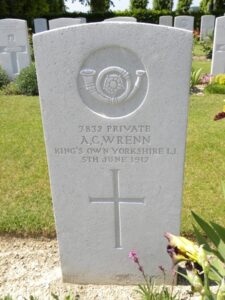Tenby is probably the most attractive town in West Wales, which can be seen by the number of visitors each summer. The town has a long history, with its castle being in a prominent position overlooking the sea, and the ancient town walls still standing. As a popular beauty spot in Victorian times, Tenby played host to a number of important families, and this can be seen in the large proportion of officers on the War Memorial, which is sited at Trafalgar Gardens. Many Thanks to Les Nixon for his much appreciated photos of the War Memorial panels from which the names of the fallen were taken. This page commemorates the men of Tenby who fell during World War One.
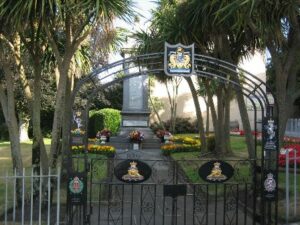
The Great War, 1914-1918
Robert Dudley Innes Ackland, Private, 19653, Royal Welsh Fusiliers. Robert was born in Tenby, the son of Dudley John James Ackland, and Francis M. Ackland. He married Jessie Louisa Rickard in Ireland in 1901, and on 17 December 1904 he enlisted in London into the Middlesex Regiment. Three months later he was discharged for misconduct and by 1911 the couple were residing at Penzance. Robert re-enlisted in London into the 8th Battalion, Royal Welsh Fusiliers. The battalion was formed at Wrexham in August 1914 as part of 40 Brigade, 13th (Western) Division. The Division moved to Mudros in July 1915 and from there moved to Gallipoli during July 1915, landing at Cape Helles. The Division then moved to the ANZAC sector, and fought at the Battles of Sari Bair, Russell’s Top, and Hill 60. They moved again, to Suvla, but were evacuated on 19 December, and moved to Helles again for a rest, but it was at Helles that they faced the last Turkish attacks, where Robert was killed in action on 6 January 1916. He is buried at Twelve Tree Copse Cemetery, Gallipoli.
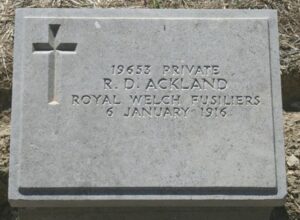
Albert Edgar Adams, Engine Room Artificer 3rd Class, D/M122, Royal Navy. Albert was born in Tenby in 1892, and served in the Royal Navy aboard HMS Hollyhock, which was an Acacia Class Sloop, launched on 1 May 1915 as a Minesweeper. She was on duty in the Far East when Albert was taken ill. He was brought ashore to the Military Hospital at Kranji for treatment, but sadly died there of malaria on 1 June 1921. Albert was 28 years old, and is buried at Kranji War Cemetery, Singapore. Albert is not commemorated at Tenby.
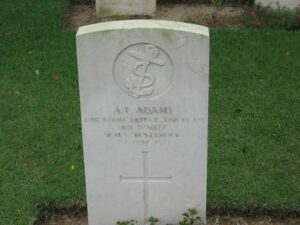
Henry Adams, Civilian. Henry was born at Tenby on 13 May 1856, the son of William Adams and Susannah Adams (nee Gunstone). Henry was a successful businessman prior to the war, and had married an American, Annie Elizabeth McNutt in 1915. The couple had booked to return to Britain aboard the RMS Lusitania four weeks after their marriage. On 7 May 1915, Lusitania was sailing past the Old Head of Kinsale, off Ireland, when she was hit by a torpedo from the German submarine U-20, and sank with the loss of 1,198 lives. Henry and Annie had boarded a lifeboat, but a wave had swept Henry overboard, and he was drowned. A casualty list from Cunard shows that Henry’s body was found, but he does not appear on the burial register of the Lusitania victims. Henry is not commemorated at Tenby, but is named on his first wife’s grave at St. Mary’s Churchyard, Tenby.
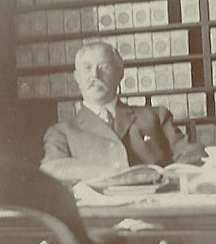
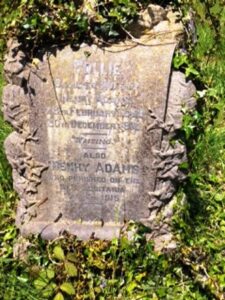
George Young Allen, MID, Company Quartermaster Sergeant, 7658, Royal Berkshire Regiment. George was born at Blewsbury, Berkshire, the son of an agricultural labourer, and was bought up and lived with his Grandparents, Stephen and Emma, in South Street, Blewsbury. George met and married Florence Selina Ollin in 1915, the daughter of Ebenezer Ollin, a Police Sergeant from Tenby. The Ollins had moved to Willesden at the turn of the century, and Florence had been born in Poplar. She married George back in Tenby, where the couple set up home at 8, Queen’s Parade, Tenby. George was a career soldier, who had originally enlisted at Reading into the 1st Battalion, Royal Berkshire Regiment, who were in Aldershot at the outbreak of war, part of 6 Brigade, 2nd Division. The Division were one of the first in France, and fought at the Battle of Mons, and during the epic fighting retreat to the Marne, where the BEF held the German attack. The Germans pulled back, and were stopped again on the Aisne, forming the basis of the Western Front line for the duration of the war. After holding the German Advance toward Paris, the Division moved to Flanders, and fought at First Ypres. They spent the winter in Flanders, and in May 1915 fought in the Battle of Festubert. They then fought at Loos in September and remained in the area throughout the winter of 1915/16, before moving to the Somme in July, 1916, where they fought at Delville Wood and the Ancre. They followed the German retreat to the Hindenburg Line in March 1917 and then fought at the opening move of the Arras Offensive, where George was killed in action during the Battle of the Scarpe, when a German shell burst on their lines, killing George and six other men, on 25 April 1917. George was 32 years old, and is commemorated on the Arras Memorial, France. George was Mentioned in Despatches a month after his death, but the details were not recorded.
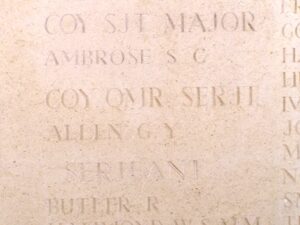
Richard Lancelot Baugh Allen, Lieutenant, Royal Field Artillery. Richard was born in Chelsea on 1 May 1886, the son of His Honour Judge Wilfred Baugh Allen and Annie Sophia Allen (nee Wedgwood), a member of the famed Wedgwood family. His parents later resided at Rosemount, Tenby, whilst Richard lived at Cilrhiw, Lampeter Velfrey. Richard followed his father into the legal profession, becoming a lawyer, and by 1914 was living in Canada. On 11 November 1914 he enlisted at Victoria, British Columbia, into the Canadian Mounted Rifles. He later received a commission into the Royal Field Artillery and married Marion Irvine whilst based in Preston, Lancashire on 12 June 1917. Richard was then posted to Egypt, joining the 67th Brigade, RFA, which was attached to the 13th (Western) Division and had moved there in early September 1917. On 3 February 1918 Richard was found guilty by Court Martial held at Kantara, after being found drunk on duty. He was obviously by now suffering from stress brought on by his war service, and committed suicide by shooting himself in the head with his revolver on the morning of 27 December 1918. Richard was 31 years old, and is buried at Cairo War Memorial Cemetery, Egypt. Richard is not commemorated at Tenby but at Lampeter Velfrey.
Fergusson Barclay, Captain, Royal Air Force. Ferguson was the son of Captain Henry Fergusson Day Barclay, 63rd Regiment, and Agnes Hermione Barclay of Manor Mead, Weston-super-Mare. The family had lived at Agnes’ home town of Tenby for several years prior to Fergusson being educated at St. Peter’s, Weston-super-Mare, and at Malvern College. He was commissioned into the Somerset Light Infantry at the outbreak of war. Ferguson was then transferred into the Royal Defence Corps, before being promoted to Captain with the Royal Air Force. It was while in their service that Ferguson was wounded during a flying accident. He was hospitalised at Harling Road Hospital, Norfolk, but sadly died there on 7 December 1918. Ferguson is buried at Weston-Super-Mare Cemetery, Somerset.
William Beadon, Lieutenant-Colonel, Indian Army. William was the son of Gen. Edward Musgrave Beadon of the 85th K.S.L.I., and Harriette Richards Beadon (nee Lloyd), of Tenby. Prior to the war he resided with his wife Joanna Elizabeth Beadon (nee Ballard), at 74, Lexham Gardens, London. At the outbreak of war he was Commanding Officer of the 51st Sikhs (Frontier Force), attached to 28 Infantry Brigade, Meerut Division, based at Murree. The 51st Sikhs served on the Suez Canal for a while, before moving into Mesopotamia, attached to the 7th Division of Major General Younghusband. In December 1915 a British Division had retreated into the town of Kut-el-Amara, where they became besieged by Turkish forces. Several attempts were made to try and relieve the beleaguered force, but to no avail. William was killed in action during the first attempt to relieve Kut, during the Battle of Wadi on 13 January 1916. He was 49 years old, and is buried at Amara War Cemetery, Iraq.
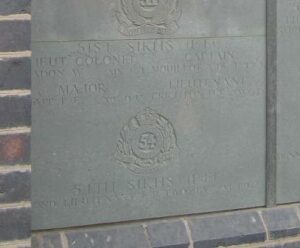
Lionel William Richard Benson, Gunner, 371219, Royal Garrison Artillery. Lionel was the Eldest son of William Walter Benson and Mary Anne Benson, of Gaspard House, Clareston Road, Tenby. He had enlisted at Milford Haven into the Royal Garrison Artillery, and been posted to their 68th Siege Battery in France. The Battery were armed with the 30 cwt 6″ Howitzer, and they fought during the Gommecourt Offensive in July 1916. After spending the remainder of 1916 on the Somme, the Battery moved to Arras, which is where Lionel was wounded. Lionel died of wounds on 30 April 1917, aged 23, and is buried in Ste. Marie Cemetery, Le Havre, France.
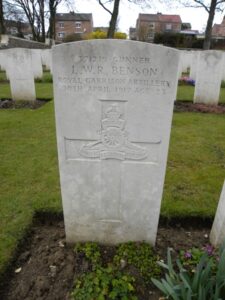
Howard Benjamin Best, Private, 379343, Labour Corps. Howard was born at Camden Town, London on 29 December 1891, the son of Benjamin Best and Emily Tabitha Best (nee Johns). By 1901 Emily had moved back to her native Tenby with the young Howard, residing at 4, Belmont Parade, Tenby. Howard had married Nellie Bushell at Pembroke on 27 September 1915, and was a hairdresser prior to the war, enlisting at Carmarthen into the Royal Fusiliers on 25 June 1917. He initially served in their Training Battalion at Edinburgh. He was posted to France on 29 September 1917, and transferred into the Labour Corps, serving with the 260th Area Employment Company. Howard was on the rifle range at Toutencourt on 4 December 1917, when an unexploded trench mortar round blew up, killing him and injuring several other men. A court on inquiry was held, which discovered that an unexploded round had been hidden under duckboards on the range by an unknown person, and that the explosion was accidental. Howard was 25 years old, and is buried in Toutencourt Communal Cemetery, France.
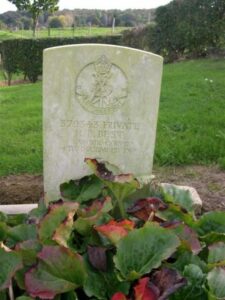
Henry Lewis Bevan, Private, 5444, Pembroke Yeomanry. Henry was born in July 1875, the son of William and Sarah Bevan, of Corse House, Laugharne. Henry had married Kate Wright, a widow from Tenby on 11 June 1900, setting up home at Upper Frog Street in Tenby where the couple ran a shop, and raised Henry’s four children, and Kate’s four children from her previous husband, Henry Wright. Henry had served for four years with the Pembroke Yeomanry, before being called up for service again, attesting at Pembroke on 14 July 1915. Henry rejoined his old Regiment, the Pembroke Yeomanry, and was given the Regimental Number 5444, joining the 2/1st Battalion, which was stationed at Lowestoft. While at Lowestoft the Battalion saw action when the German Navy attacked and bombarded the Fishing Town, causing many casualties among the Civilian Population. Henry had become ill while at Lowestoft, and on 5 January 1917 was discharged from the Army as being no longer fit for duty, and he returned to Tenby. Henry was discharged with 20% disability and granted a Pension, and every subsequent medical examination on his Pension Record shows a rapid worsening of his condition, which culminated in Henry sadly dying on 27 August 1919 at home in Tenby, aged 45. Henry was buried at St. Mary’s Church Cemetery in Tenby.
Harold Berkeley Beynon, Private, 33181, Hampshire Regiment. Harold was born in 1897, the son of Thomas Beynon and Laura Annie Beynon (nee Thomas), of Holloway Farm, Penally. He later resided at St. Johns Hill, Tenby, where he worked as a groom prior to enlisting into the Pembrokeshire Yeomanry on 1 April 1914. Following the outbreak of war, Harold was mobilised with the Pembroke Yeomanry, but was soon transferred to the 3rd Battalion, Welsh Regiment. Due to his young age, he remained on home service until being drafted to Salonika on 17 October 1916, joining the 10th Battalion, Hampshire Regiment, which was attached to 82 Brigade, 27th Division. Harold became ill with malaria while in Salonika and returned home for treatment. His service papers show that he was discharged on 17 April 1919 due to ill health following his bout of malaria. His health declined rapidly after being discharged from the army and he died at home of meningitis and encephalitis on 6 May 1919. The 21-year-old was buried in St. Florencius Churchyard, St. Florence. He was originally not commemorated as a war casualty by the CWGC, but following my research, he has recently (January 2012) been accepted for commemoration by the CWGC, who initially added his name to the Brookwood (1914-1918) Memorial, where it remained until the location of his grave was verified. Harold is also commemorated on a plaque within St Florence Church and on the Penally war memorial.
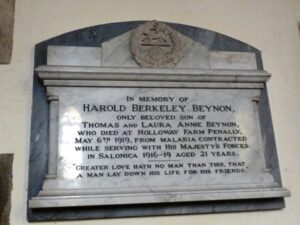
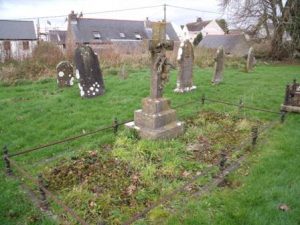
Charles Thomas Bickerstaff, Private, 19861, Welsh Regiment. Charles was born at Brixton on 6 July 1896, the son of Charles and Kathleen Elizabeth Bickerstaff. Both parents had died by 1902 and, after leaving school, Charles moved to west Wales, becoming a Baker’s Apprentice at Pembroke by 1911. Prior to the war he was residing at Milton. Charles enlisted at Pembroke into the Army, and joined the 15th Battalion of the Welsh Regiment, the ‘Carmarthen Pals’. The battalion was raised in October 1914 and formed at Rhyl, where it became part of 114 Brigade, 38th (Welsh) Division, and embarked to France in December, 1915. After several months training in the ‘Nursery Sector’ around Fleurbaix, the division moved south to take part in the Battle of the Somme, and were allotted the task of taking the strongly defended Mametz Wood. The first attack went in on 7 July 1916, but it wasn’t until 11 July that the wood was finally cleared, after much bloodshed. Charles was killed in action at Hebuterne, just after the division was withdrawn from the wood, on 14 July 1916, aged 20. His grave was lost during the continued fighting on the Somme, and so Charles is commemorated on the Thiepval Memorial, France.
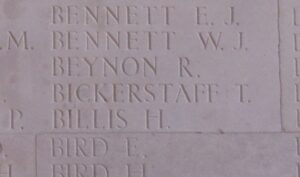
William Henry Bodill, Bandsman, 5629, 10th Prince Of Wales’ Own Royal Hussars. William was the son of William and Charlotte Elizabeth Bodill, of Folkestone, Kent. He was residing in Saundersfoot prior to the outbreak of war, and enlisted at Cardiff into the 10th Prince Of Wales’ Own Royal Hussars, who were stationed in South Africa at the start of the war. In August, 1914 they sailed from Cape Town, and upon their arrival in England joined 6th Cavalry Brigade, 3rd Cavalry Division. On the 8th October the Division landed at Ostend, where they fought during the Defence of Antwerp. The then moved to Ypres, where they took part in First Ypres, and in 1915 fought at Second Ypres and the Battle of Loos. They were in reserve on the Somme, waiting for the breakthrough that never came, when William was wounded. He was brought back to the Casualty Clearing Station, where he died of Wounds on 10 October 1916, aged 25. He is buried at Contay British Cemetery, France. William is also commemorated on the Saundersfoot War Memorial.
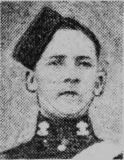
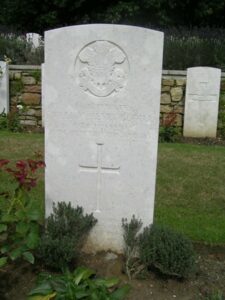
Walter Borrowes, Lieutenant, Royal Navy. Walter was born at Tenby in 1892, the son of Florence Elizabeth Borrowes. He served in the Royal Navy aboard H.M. Submarine C31. At the beginning of January 1915 C31 sailed from Dover to patrol off Zeebrugge. The submarine was due to arrive at Harwich on 7 January, which she failed to do. No further contact was made and a search conducted by the Destroyers Lercher and Firedrake and the Royal Navy Air Service failed to locate the submarine or any survivors. She had in fact grounded off Zeebrugge on 4 January 1915 and was destroyed by German land batteries. Walter is recorded by the CWGC as having died on 7 January 1915, aged 22, but was in fact killed on 4 January 1915, when C31 was destroyed. He is commemorated on the Portsmouth Naval Memorial, Hampshire.
Percy William Innes Boswell, Sergeant, 1764, Manchester Regiment. Percy was born at Tenby in 1892, the son of Master Gunner James Grinton Smith Boswell and Jane Kay Boswell. By 1901 James had retired from the army, and the family were residing at 58, Llanfair Road, Canton, Cardiff. Percy had graduated from the Welsh University with a B.Sc., and had moved to Cardigan prior to the war. Percy enlisted at Manchester into the 1/6th Battalion, Manchester Regiment, which was attached to 127 Brigade, 42nd (East Lancashire) Division. The Division sailed from Southampton on 10 September 1914 to Egypt, to garrison the Suez Canal. Arriving on 25 September, the Division concentrated around Cairo, leaving the Manchester Brigade at Alexandria. They remained in Egypt until April 1915, and on 1 May embarked at Alexandria to join the Gallipoli expedition. On 6 May 1915 the Division landed at Cape Helles, and from that time on fought continuously through the campaign, where Percy was Killed in action on 7 August 1915, aged 23. He is commemorated on the Helles Memorial, Gallipoli. Percy is not commemorated at Tenby.
Foss Hunter Brown, Second Lieutenant, Royal Engineers. Foss was born at Gosforth, Newcastle-on-Tyne, the son of John Samuel and Elizabeth Annie Brown. The family later resided at 36, Victoria Street, Tenby. Foss received a commission into the Royal Engineers, and served with the 76th Field Company, Royal Engineers. The Field Companies were the technical men of the army at the time, and the 76th Field Company arrived in France attached to the 16th (Irish) Division. They moved to the Guards Division in August, 1915, and landed in France with them that month. The first action seen by the Guards Division was during the Battle of Loos. They then fought at Flers-Courcelette and Morval on the Somme, before following the German withdrawal to the Hindenburg Line in March 1917. The Division then moved to Ypres, and took part in the Battle of Pilckem, where Foss was Killed in action, on 31 July 1917, aged just 19. He is buried at Duhallow A.D.S. Cemetery, Belgium.
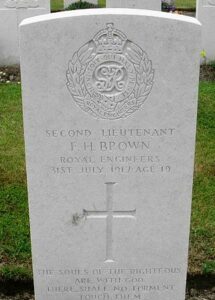
Eric James Kershaw Buckley, Flight Sub Lieutenant, Royal Naval Air Service. Eric was born at 2, Pembroke Villas, Tenby on 15 April 1895, the son of James Kershaw and Charlotte Buckley. His father died when he was young, and his mother moved the young family to 6, Dry Hill Park Road, Tonbridge, Kent. Eric was educated at Tonbridge School, and at Queen’s College, Cambridge, and was studying to take Holy Orders when he enlisted into the Royal Naval Air Service on 16 July 1916. Eric served in France from 23 May 1917, based at the Dunkirk Air Station, and was the holder of the Cross of the Order of the Crown of Belgium, and the Croix de Guerre (Belgium), after having shot down two German aircraft during his first ever flight. Eric was flying his Sopwith Pup, serial N6174, when he was shot down in the Channel and killed, probably by B Heinrich, on 28 July 1917, aged 22. It was almost six weeks later that Eric’s body was washed ashore at Renesse, and he was buried at Flushing (Vlissingen) Northern Cemetery, Netherlands.
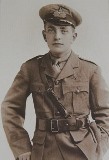
William Buley, Third Mate, Mercantile Marine Reserve. William was born at Tenby in 1872, the son of John and Elizabeth Buley. He was a Merchant Seaman for many years prior to the war, and after the outbreak of war joined the Mercantile Marine Reserve, and was posted aboard H.M. M.F.A. Lyons, which was based at Cromarty in the Orkneys. William died on 10 August 1914, aged 42, and is buried at Cromarty Cemetery, Scotland.
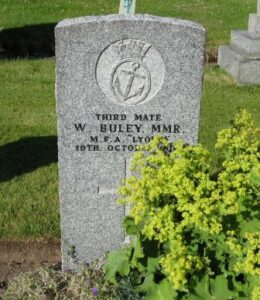
Henry Simeon Burton, Lance Sergeant, 6952, Duke of Edinburgh’s (Wiltshire Regiment). Henry was born at Salisbury in 1886, the son of Edward and Louisa Burton. He enlisted into the Wiltshire Regiment on 18 May 1904. Whilst based at Pembroke with the Wiltshire Regiment he met and married Elizabeth Annie Smith from Tenby in 1907. The couple set up home at 8, Lower Saltern, Tenby, where Henry found work as a gas stoker, and their two children were born. At the outbreak of war, Henry rejoined the 1st Battalion, Wiltshire Regiment, which was attached to 7 Brigade, 3rd Division, and they moved to France in August 1914, fighting at the Battle of Mons, and the epic retreat south via Le Cateau to the Marne where the Germans were stopped. After pushing the Germans back to the Aisne, the Division moved to Flanders, and fought at La Bassée, Messines and First Ypres before spending the winter in Flanders, and taking part in the famous Christmas Truce that year near Ploegsteert. In 1915 they fought at Bellewaarde and Hooge during Second Ypres, and on 18 October 1915 the Battalion transferred to the 25th Division. They were at Vimy when the Germans attacked in May 1916, and after a brief rest period moved to the Somme to take part in the big offensive. Henry was wounded on the Somme, during the capture of Hindenburg Trench on 25 August 1916. He was admitted to No 3 Casualty Clearing Station for treatment before being sent to Maida Vale Military Hospital, where he died of his wounds on 23 September 1916, aged 31. He is buried in Tenby (St. Mary) Church Cemetery.
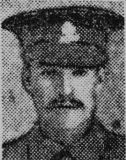
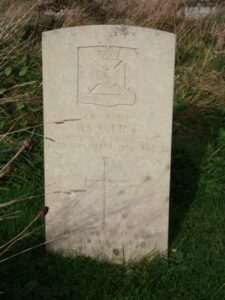
John Richards Carne, Private, 18582, Welsh Regiment. John was born in Tenby in 1880, the son of Henry Carne and Elizabeth Carne (nee Richards). He resided at Bridgend prior to the war, and married Georgina Angove there in 1906. The couple had two children, George and Edward. John enlisted at Cardiff into the 2nd Battalion, the Welsh Regiment, which was sent to France as part of 3 Brigade, 1st Division, landing at Havre on 13 August 1914. After the retreat from Mons to the Aisne, they were moved to Ypres, and again stopped the Germans during First Ypres. They moved to the French Flanders sector near Neuve-Chapelle in that first winter, where John was sadly killed in action on 22 December 1914, aged 34. He is commemorated on the Le Touret Memorial, Richebourg L’Avoue, France.
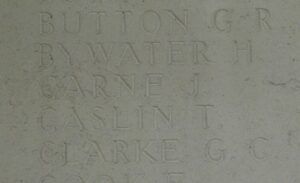
Thomas Henry Coffey, Private, 31843, South Wales Borderers. Thomas was born in Bedwas in 1886, the son of George John Coffey and Mary Coffey (nee Morgans). Thomas was a Police Constable prior to the war, and had married Ethel Annie Fairfax in 1905. He had returned to his mothers native Pembrokeshire to serve as a Police Constable, first at Pembroke, and then at Tenby, taking his wife and five children. Thomas enlisted at Aldershot into the Military Foot Police. Thomas later transferred into the 8th Battalion, South Wales Borderers, which was attached to 67 Brigade, 22nd Division. The Division landed at Boulogne on 6 September 1915, but were almost immediately ordered to proceed to Marseilles, embarking there on 30 October for Salonika. They remained here for the duration of the war, and sadly Thomas died of dysentery at the 42nd General Hospital, Salonika on 6 September 1918, aged 32. He is buried at Salonika (Lembet Road) Military Cemetery, Greece.
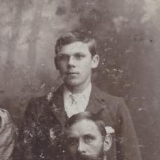
Thomas James Collacott, Petty Officer 1st Class, 142707 (Dev.), Royal Navy. Thomas was born at Devonport on 9 February 1872, the son of John and Elizabeth Collacott. He married Matilda Ann Nicholls at Tenby in 1904, and was a long serving Royal Naval seaman. Thomas served aboard the liner S.S. Laurentic, as a Petty Officer. Laurentic had been commissioned by the Admiralty as H.M.S. Laurentic, an armed merchant cruiser, and used as a troop transport ship. On 25 January 1917 she struck a mine off Malin Head, Southern Ireland, and sank with the loss of 347 crew. Thomas was 44 years old, and is one of just 23 of the crew that have a burial, as he is buried in Upper Fahan (St. Mura’s) Church Of Ireland Churchyard, County Donegal, Ireland.
William Cornell, Private, L/7421, Middlesex Regiment. William was born at Saffron Walden, Essex and lived at Tenby at some time prior to the war. At the outbreak of war, William was serving as a Private with the 4th Battalion, Middlesex Regiment, stationed at Devonport as part of 8 Brigade, 3rd Division. On 14 August 1914 the battalion landed at Boulogne, and moved to the Belgian border, where they took part in the Battle of Mons, and the subsequent retreat south to the Marne, where the German advance was stopped. They took part in the advance to, and Battle of the Aisne, before moving to positions near Messines, south of Ypres. William was wounded soon after, and died of wounds on 21 November 1914. He has no known grave, and is commemorated on the Ploegsteert Memorial, Belgium.
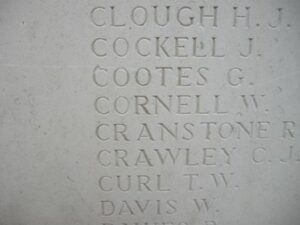
Joseph Clement Cossins, Bombardier, 950475, Royal Field Artillery. Joseph had been born in London, the son of Louis and Maria Cossins, and the family moved to Tenby, setting up home at “Scarborough House,” The Paragon, Tenby. Joseph enlisted into the Royal Field Artillery, and served in their “B” Battery, 235th Brigade, which was a pre-war Territorial unit, attached to the 47th (London) Division. The Division moved to France in March, 1915 and saw action during most of the major battles thereafter, fighting at Aubers, Festubert, Loos, Vimy, and the Somme Offensive. They fought during the opening of Third Ypres, at the Battle of Messines, and then at Cambrai later in 1917. When the German Spring Offensive was launched in March 1918, the Division were caught in the thick of it, during the Battles of St. Quentin and Bapaume. It was during the terrible period that followed that Joseph was killed in action, on 5 July 1918, aged 27, and he is buried at Daours Communal Cemetery Extension, France. Joseph is not commemorated at Tenby.
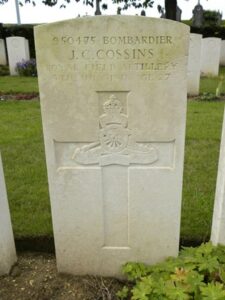
Edward John Cutcliffe, Private, 57136, Royal Welsh Fusiliers. Edward was the son of William Henry and Martha Jane Cutcliffe, of ‘Wynlerg,’ Church Park, Tenby, and originally enlisted into the Welsh Regiment. He later transferred into the 2nd Battalion, Royal Welsh Fusiliers, which had been in France since the outbreak of war, attached to 19 Brigade, which was used to plug gaps in badly depleted divisions. Towards the end of the war, Edward was attached to 121 Brigade Head Quarters, and died of illness on 5 October 1918. He was 31 years old, and is buried at La Kreule Military Cemetery, Hazebrouck, France.
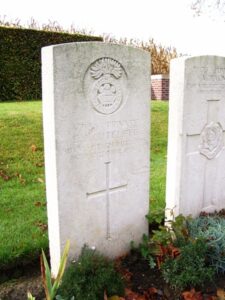
Arthur Davies, Petty Officer, ON5102, Royal Australian Navy. Arthur was born in Tenby on 29 March 1889. He served with the Royal Navy prior to the war, and had served in operations off Somaliland before emigrating to Australia with his wife Alice Florence Davies, after being attached to the Royal Australian Navy on 1 July 1912. The couple made their home at Marrickville, New South Wales. On 3 March 1914 he passed as a Petty Officer and took part in operations on German New Guinea, under the command of Commander John Arthur Hamilton Beresford, another Welshman, who had been born in Laugharne. Arthur served aboard the cruiser HMAS Encounter until 1 March 1916 when he was posted to the converted clipper HMAS Tingira, which had been requisitioned for use as a training ship. He died of influenza on 21 June 1919, aged 30, and is buried in Sydney North Head (Quarantine) Cemetery, Australia. Arthur does not appear to be commemorated locally.
Gilbert Douglas Davies, Private, 56886, Welsh Regiment. Gilbert was the son of William Henry and Sarah Ann Davies, of Toronto Cottage, Clareston Road, Tenby. He enlisted at Carmarthen on 5 July 1915 into the Pembroke Yeomanry. On 4 August 1916 Gilbert landed in France, and was posted to the 13th Battalion, Welsh Regiment, which was attached to 114 Brigade, 38th (Welsh) Division, joining the battalion at Ypres, where it was rebuilding after the fighting at Mametz Wood. The 38th Division was by then in positions at the Canal Bank, north of Ypres, and it was here during his first winter on the Western Front that Gilbert was wounded on 15 January 1917. He was evacuated to the 46th Casualty Clearing Station at Mendinghem for treatment, but sadly died of wounds there on 17 January 1917, aged just 21. He is buried at Mendinghem Military Cemetery, Belgium.
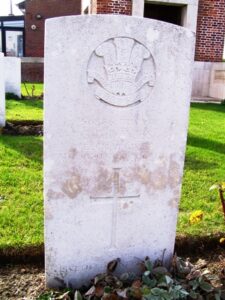
John Alfred Davies, Sapper, 302677, Royal Engineers. John was born at Llandeilo in 1877, the son of William and Eliza Davies. By 1891 the family was residing at 4, Park Terrace, Tenby, where John worked as a builder for his father. John served in the Royal Engineers with the Inland Waterways and Docks Company, which was a specialist arm of the Royal Engineers, providing services to develop and operate transport on the canals and docks. Not much can be found of John’s part in the war, but he died of disease on 5 August 1917, aged 39, and is buried at Tenby (St. Mary) Church Cemetery.
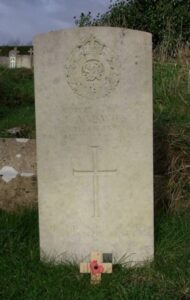
Joseph Davies, Private, 14040, Kings Shropshire Light Infantry. Joseph was the son of Joseph and Mary Davies, of St. Mary’s Hill Cottage, Tenby, and lived at Trelewis prior to the war. He enlisted at Merthyr Tydfil into the Army, joining the 7th Battalion, King’s Shropshire Light Infantry, attached to 76 Brigade, 3rd Division. One of the first Divisions to move to France, the 3rd Division remained on the Western Front throughout the war, and fought during the opening Battle of Mons, and in the epic retreat, from the Rearguard Action of Solesmes, through the Battle of Le Cateau, and down to the Marne, where the German Offensive was stopped. They followed the German withdrawal to the Hindenburg Line, where they met them in battle, and stopped the advance on Paris. The Division then moved north to Flanders, and took part in the Battle of La Bassée, and at the Battle of Messines, which were a prelude to the First Battle of Ypres. They took part in the famous Christmas Truce on the 25th December, 1914 and remained at Ypres throughout the winter. In 1915 the Division saw action at Bellewaarde and Hooge, and took part in the Second attack on Bellewaarde, and in 1916 fought at the Actions of the Bluff, and at the St Eloi Craters. They were then moved south to the Somme, where they were to take part in the great Battle of the Somme, and fought there at the Battle of Albert, and at the Battle of Bazentin, where they captured Longueval. Joseph was killed on the Somme on 14 July 1916, aged 25. He is commemorated on the Thiepval Memorial, France. Joseph is also commemorated on the Saundersfoot War Memorial.

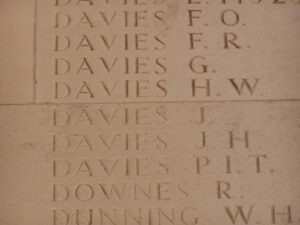
Robert Henry Davies, Private, 62306, Welsh Regiment. Robert was the son of James and Elizabeth Davies of Westbourne Cottage, Tenby. He worked as a Porter with the G.W.R. at Llanelli prior to the war, and resided at Tyasha Road, Llanelli. Robert enlisted at Llanelli into the Welsh Regiment on 13 December 1915, and was posted to France on 15 March 1918, where he joined the 15th Battalion, Welsh Regiment, which was the Carmarthen Pals battalion. The battalion was attached to 114 Brigade, 38th (Welsh) Division, and Robert joined them at Armentieres. During April 1918 the Division moved to the Somme, and took up positions north of Albert, around Aveluy Wood. They remained here until launching their offensive across the River Ancre on 21 August 1918, which began their drive across the old battlefields towards the Hindenburg Line. When the Hindenburg Line had been broken, the Welshmen drove towards Le Cateau, and the Forest of Mormal. Robert was killed while the 15th Welsh were fighting around Pierre Mill on 8 October 1918. He was 25 years old, and is buried at Moulin-De-Pierre British Cemetery, France.
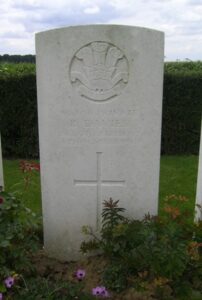
Thomas Maurice Davies, Sergeant, 6017, Welsh Regiment. Thomas was born on 23 October 1879 at Penffordd, Bletherston. Thomas worked at Narberth Post Office prior to 1898, and served with the 1st Volunteer Battalion, Welsh Regiment. In 1899 the Battalion was sent to South Africa to fight in the Boer War. Thomas was awarded the QSA and KSA for his time in South Africa, and moved to India with the 2nd Welsh in 1902, not returning to Wales until 1905. In 1908 he married Elizabeth Morgan of Tenby, and resided at Lodge Gate, New Hedges, Tenby, with Thomas working there as a Postman. Thomas re-enlisted at Pembroke Dock at the outbreak of WW1, into the 8th Battalion, the Welsh Regiment, which were part of 40 Brigade, 13th (Western) Division. In January 1915 the Battalion became the Divisional Pioneers, and in June, 1915 the Division embarked for the Mediterranean, and from there to Gallipoli via Mudros, landing at ANZAC Cove from 3 August 1915. On Gallipoli, the Division fought in the Battles of Sari Bair, Russell’s Top and Hill 60, before moving to Suvla Bay, from where they were evacuated in January 1916. After being moved to Egypt, the Division was sent to Mesopotamia, as part of a force to relieve the Siege of Kut el Amara. Thomas was killed in action here, at Abu Romans Mound, near Sannyiat, Mesopotamia, aged 36, on 23 April 1916. He has no known grave, and so is commemorated on the Basra Memorial, Iraq.
William Davies, Petty Officer Stoker, 160757, Royal Navy. William was born on 7 September 1870, the son of Mr. and Mrs. Davies, of Tenby, and the husband of Harriet Davies, of 98, St. Leonard’s Road, Kirkley, South Lowestoft. He was a pre-war regular in the Royal Navy, serving aboard their Canopus Class Battleship HMS Goliath. She had been launched on 23 March 1898 and commissioned at Chatham on 27 March 1900. Designed for the China station, she had a narrow draught, to enable her to use the Suez Canal. She remained there until 1903, and in 1904 went into commissioned reserve at Portsmouth. In May 1905 she joined the Mediterranean fleet, transferring to the channel fleet in December and remaining there until March 1907. She was then commissioned in April 1909 at Sheerness for the 4th Fleet (Nore Reserve). HMS Goliath was mothballed in 1913, and joined the 3rd Fleet (Pembroke Reserve), to be brought out in August 1914 to join the battle squadron operating from Devonport. Her complement was drawn up from the naval reserve on 2 August 1914, and she was dispatched in September 1914 to the East Indies for escort duties, operating against the German light cruiser Konigsberg in November (Rufigi River, East Africa). In April 1915 she was transferred to the Dardanelles, to support the ill-fated landings around Cape Helles. She was damaged on 25 April and again on 2 May, and then finally sunk by three torpedoes fired by the Turkish torpedo boat ‘Muavanet’ on 13 May 1915. 570 of her crew were lost, including the 44 year old William. His body went down with the ship, and so he is commemorated on the Plymouth Naval Memorial, Devon.
Francis Innes Day, Major, Royal Munster Fusiliers. Francis was born on 21 January 1870, the son of Colonel Henry James Day, Wiltshire Regiment. In 1903 he married Florence Stokes, of Tenby, and the couple set up home at 15, Nightingale Road, Southsea. Francis was a career soldier, and at the outbreak of war was a Major with the 2nd Battalion, Royal Munster Fusiliers, part of 1st Guards Brigade, 1st Division. On the 14 August 1914 the battalion landed at Le Havre and moved to positions near Mons, where they saw their first action, before taking part in the retreat to the Marne, where the Germans were stopped. They then fought at the Aisne, and at Chivy, before being moved north to Ypres. Here they fought at the First Battle of Ypres, where they again stopped the German Offensive, before wintering in Flanders. Francis was killed in action near Festubert on 21 December 1914, aged 43. He has no known grave, and is commemorated on the Le Touret Memorial, Richebourg L’Avoue, France.
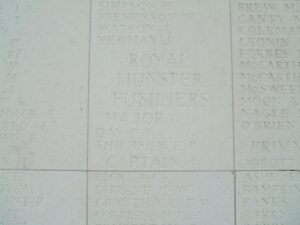
William Eden, Private, 20076, Kings Shropshire Light Infantry. William was born at St. Helens, Lancashire in 1893. He married Clara Jane Daniels, of 26, Culver Park Tenby on 6 December 1915. William enlisted at St. Helens into the Army, joining the 10th Battalion, Kings Shropshire Light Infantry. The battalion had been formed by the merger of two dismounted Yeomanry regiments (the Shropshire and Cheshire Yeomanry) and attached to 231 Brigade, 74th (Yeomanry) Division. The division fought throughout the campaign in Palestine, leading up to the capture of Jerusalem in December 1917, but were called to the Western Front in April 1918 after the British Army had suffered huge losses due to the German Offensives on the Somme and the Lys. The 74th Division sailed to Marseilles, before entraining for Flanders, before returning to the Somme and fighting at the Battle of Épehy, as part of the offensive towards the Hindenburg Line. William was killed in action during the advance to the Canal du Nord, on 3 September 1918, aged 25. He is buried at Sailly-Saillisel British Cemetery, France.
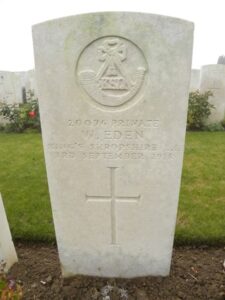
John Evans, Gunner, 371058, Royal Garrison Artillery. John was the son of James and Elizabeth Evans, of 2, Jubilee Cottages, Tenby. He enlisted at Tenby into the Royal Garrison Artillery, and served with their 114th Siege Battery. The Battery was formed at Pembroke Dock on 3 March 1916 and moved to France on 14 June 1916. It comprised of four 6″ Howitzers, and fought on the Somme, and at Vimy Ridge, where they were attached to the Canadian Corps. The Battery had moved to Flanders to prepare for the forthcoming Battles of Third Ypres, when John was killed in action on 14 June 1917, aged 36. He is buried at Belgian Battery Corner Cemetery, Belgium.
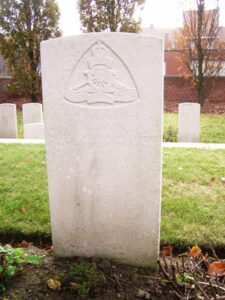
William George Evans, Lance Corporal, 381481, Kings Liverpool Regiment. William was the son of John Evans, Tenby. He resided in Tenby prior to the war and enlisted there into the army. He was posted to the 5th Battalion, King’s Liverpool Regiment, which had been in France since 22 February 1915, attached to 6 Brigade, 2nd Division. William probably joined the battalion in 1917, and would have fought at the Battle of Cambrai, where the Division was decimated during the German counter-attacks. In 1918 the Division moved to Festubert, and in April met with the ferocious onslaught of the German Offensive in Flanders. After the Battle of Estaires, the Division had made a stand that was to become famous, gaining the respect of even the German High Command. After a hard campaign in Flanders, the tide turned in favour of the Allies, and the Division took part in the final advance in Flanders. William was killed in action during this epic push, on 21 October 1918, and is buried at Ere Churchyard, Belgium. His is one of only two burials here.
William Maberly Fatt, Lieutenant (Pilot), Royal Flying Corps. William was born on 12 May 1892 in Ontario, the son of the Reverend Frederick Helling Fatt and Sarah Fatt, of Victoria, British Columbia, Canada, and was the husband of Marjorie Hannah Fatt. He attested on 9 December 1914 at Ontario, and was taken on as a Lieutenant in the Canadian Expeditionary Force, due to his previous three years service in the Canadian Corps Cyclist Battalion. William lived at Tenby during the first few months of his time in Britain, and then volunteered for Pilot training with the Royal Flying Corps. He was training in the UK on 4 January 1917 when he fell from his aeroplane and was killed. He was 24 years old, and is buried in Croydon (Mitcham Road) Cemetery. William is not commemorated at Tenby.
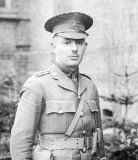
Ronald Gifford Fishwick, Private, 3047, Australian Infantry. Ronald was born at Tenby in 1870, the son of Richard Fairfax Fishwick and Elizabeth J. Fishwick, of 5, St. Julian Terrace. The family emigrated to Australia after 1911, setting up home at Esson, 217, Denison Street, Waverley, New South Wales. Ronald enlisted at Liverpool, New South Wales on 10 April, 1915 into the 1st Battalion, Australian Infantry, and was sent to Egypt as part of the 10th Reinforcements for the Battalion, which was part of the 1st Brigade, 1st Australian Division, fighting at Gallipoli at the time. Ronald arrived in Egypt in January, 1915, after the evacuation of the Australians from Gallipoli. After a spell of training in Egypt, the AIF was sent to France, landing at Marseilles on 28 March 1916, and moved to the ‘Nursery Sector’ near Armentieres. In July 1916 the Australian 1st and 2nd Divisions moved south to the Somme, where the First Division attacked the German stronghold of Pozieres on 22 July 1916. The battle raged for days, but the men of the AIF successfully captured Pozieres, at great cost, and Ronald was reported missing during the capture of the village, sometime between 22 and 25 July 1916. A later court of enquiry came to the conclusion that Ronald had been killed in action, and as his body was lost in the ongoing fighting in the area. Ronald was 21 years old, and is commemorated on the Villers-Brettoneux Memorial, France.
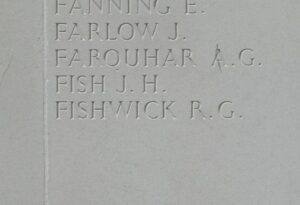
Charles Frederick Arthur Fordham, Private, 53684, Welsh Regiment. Charles was born in 1894, the son of George and Martha Fordham, of St. John’s Croft, Tenby. He enlisted there into the Pembroke Yeomanry, and was later transferred into the 2nd Battalion, Welsh Regiment, which was sent to France as part of 3 Brigade, 1st Division, landing at Havre on 13 August 1914. After the retreat from Mons to the Marne, where the Germans were stopped, they fought at the Aisne, and were then moved to Ypres, again stopping the Germans during the Battle of First Ypres. They moved to the French Flanders sector near Neuve-Chappelle in that first winter, and fought at Aubers, before moving south again, and fighting at the Battle of Loos. After a few months spent at Loos, the Division moved to the Somme, where they fought in most of the Battles of the Somme Offensive in 1916, and were in the area in March 1917 when the German withdrew to the Hindenburg Line. Charles was killed in action about this time, on 3 March 1917, aged just 22, and he is buried at Assevillers New British Cemetery, France.
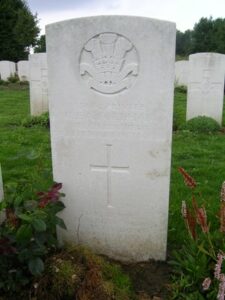
Alfred William Forsyth, Private, 200206, Welsh Regiment. Alfred was born in 1893, the son of Annie Glinn, of 1, Bridge Street, Tenby. He enlisted at Pembroke into the 1/5th Battalion, Welsh Regiment. The Battalion was formed at Pontypridd during August 1914, and on 17 April 1915 were attached to 159 Brigade, 53rd (Welsh) Division. In July 1915 the Division sailed from Devonport for Egypt, and from there were landed at Gallipoli on 9 August 1915. From here on they fought throughout the remainder of the disastrous campaign on the Peninsula, which resulted in such a terrible loss of men that the merging of the 4th and 5th Welsh became necessary for several months, during which the Division were evacuated to Egypt in December 1915. After spending some time defending the Suez Canal, the Division moved to Palestine, and fought through the Battles of Gaza, before finally capturing Jerusalem in December 1917. Alfred was killed in action on 28 December 1917, aged 24, and is buried at Jerusalem War Cemetery, Israel.
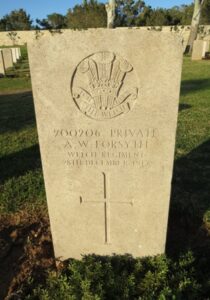
Henry James Fouracre, Gunner, 141470, Royal Garrison Artillery. Henry was born at Grangetown, Glamorgan, and prior to the war resided at Princes Head, Tenby, where he worked as a fisherman. He enlisted at Pembroke Dock into the Royal Garrison Artillery, serving with their 148th Siege Battery on the Western Front, after being formed at Harwich on 22 May 1916. Henry was killed in action during Third Ypres, on 20 October 1917, aged 33, and he is buried at The Huts Cemetery, Ieper, Belgium.
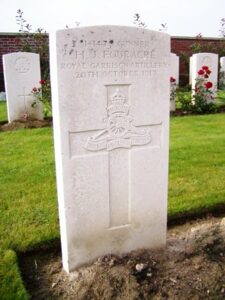
Arthur Charles Gatenby, Private, 690399, Canadian Infantry. Arthur was born on 13 June 1895, the son of William and Jennie Gatenby, of 8, Hilton Street, Hamilton, Ontario. His connection with Tenby is presently unknown, but he enlisted at Hamilton, Ontario on 28 February 1916 into the 116th Battalion (Ontario), writing on his enlistment paper that he had previously served for three years with the 91st Highlanders. The 116th Canadian Battalion formed part of 9 Canadian Brigade, 3rd Canadian Division, joining it in France during April 1917. Arthur would then have seen action during the Battle of Arras, when the Canadian Corps took Vimy Ridge, and then fought at Passchendaele later that year. Arthur was killed in action a year later, during the Battle of the Canal du Nord, on 1 October 1918. He was 25 years old, and is buried at Canada Cemetery, Tilloy-Les-Cambrai, France. Photo courtesy of Eric Reid.
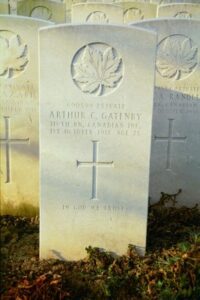
Cebert Douglas Gibbon, Sergeant, 17520, Essex Regiment. Cebert was born in 1879, the son of Thomas and Ellen Gibbon, of Tenby. He was living in London by 1901, and prior to the outbreak of war resided at 16, Witton Street, Romford, Essex, with his wife Alice Gibbon. Cebert enlisted at nearby Stratford into the 13th Battalion, Essex Regiment. The Battalion had been formed at West Ham on 27 December 1914, and in August 1915 were attached to 100 Brigade, 33rd Division and they moved to France in November 1915. On 22 December 1915 the Battalion transferred to 6 Brigade, 2nd Division, and joined their new Division at Loos, after the Battle had closed down. In July, 1916 the Division moved to the Somme, and fought at Delville Wood at the Battle of the Ancre, where Cebert was killed in action on 13 November 1916, aged 37. His body was recovered at some time after the war, and Cebert is buried at Serre Road Cemetery, No. 2, France. Cebert is not commemorated at Tenby.
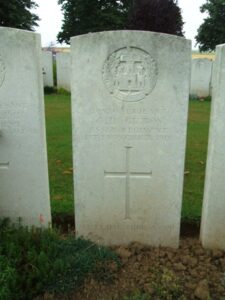
Arthur Glass, Sergeant, 6886, Duke Of Edinburgh’s (Wiltshire Regiment). Arthur was born at Swindon on 26 May 1886, the son of Frederick George Glass and Mary Ann Glass (nee Head). He worked as a postman in Swindon. Arthur married Margaret Anne Brooking, of Tenby, on 4 November 1911 and the couple set up home at Swindon. He enlisted at Swindon into the 1st Battalion, Wiltshire Regiment soon after marrying. At the outbreak of war, the Battalion was at Tidworth as part of 7 Brigade, 3rd Division. The Division moved rapidly to France, and took part in the Battle of Mons, and also at Solesmes and Le Cateau, before fighting in the epic retreat south to the Marne, where the German Offensive was stopped. The division saw heavy fighting during the Battle of the Aisne, where the Germans dug a defensive line along the Chemin des Dames Ridge, before the BEF was transferred north to Flanders. The 3rd Division entrained at Saintines, detraining at Abbeville on 6 October, then over the coming days began moving forward to new positions around Neuve Chapelle and La Bassée, before entrenching on the night of 17 October. On the following day, 18 October 1914, the Germans attacked the line in great numbers, behind an intensive artillery barrage. Arthur was killed in action here during the day. The 28-year-old has no known grave and is commemorated on the Le Touret Memorial, Richebourg L’Avoue, France.
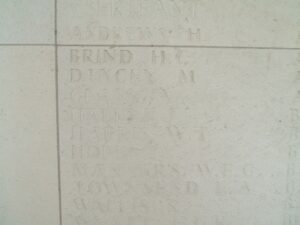
Charles Stewart Glencross, Sergeant, 371034, Royal Garrison Artillery. Charles was born in Carmarthen in 1892, the son of Richard and Caroline Glencross. The family had moved to 2, Upper Park Road, Tenby prior to 1911, and Charles enlisted at Tenby into the Royal Garrison Artillery. He was posted to France with the 204th Siege Battery, Royal Garrison Artillery. Not much is known of Charles’ war service, but he was killed in action during the opening of the German Spring Offensive during the Battle of Arras on 28 March 1918, aged 26, and is buried at Anzin-St. Aubin British Cemetery, France.
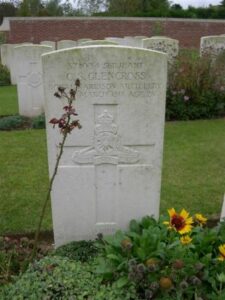
William Edward Glinn, Private, 235691, Royal Welsh Fusiliers. William was born in 1898, the son of William Edward Glinn and Annie Glinn, of Pretoria Restaurant, Bridge Street, Tenby. He enlisted at Carmarthen on 31 August 1916 into the South Wales Borderers. On 2 August 1917 William landed in France, and was transferred into the 17th Battalion, Royal Welsh Fusiliers, which formed part of 115 Brigade, 38th (Welsh) Division. The Division had been in France since December, 1915, and had fought at Armentieres, then at Mametz Wood on the Somme, and through the Battle of Third Ypres at Pilckem and Langemarck. When the German Spring Offensive hit the Allies on the Somme in March 1918, the 38th Division were rushed to positions around Albert, where they remained until the German Offensive was turned by a brilliant Australian victory on 8 August 1918 at Villers-Brettoneux. The German Army had now been bled dry, and the Allies swiftly moved toward the mighty Hindenburg Line, and it was during this advance over the old battlefields that William was wounded, after being shot in the back. He was moved to the Base Hospital at Rouen, where he sadly died of Wounds on 9 September 1918, aged 20. William is buried there, at St. Sever Cemetery Extension, Rouen, France.
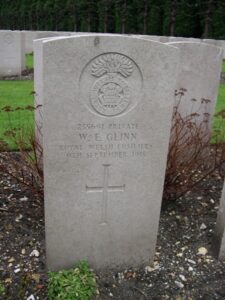
Richard John Goodridge, Private, 34602, Welsh Regiment. Richard was born in 1878, the son of Thomas and Jane Goodridge, of 17, St. George Street, Tenby. Prior to the war he resided at Treorchy, and enlisted at Tonypandy into the 20th Battalion, Welsh Regiment, which had been formed during July, 1915 as a local Reserve Battalion. Sadly Richard died at home on 18 November 1915, aged 37, and is buried at Tenby (St. Mary) Church Cemetery.
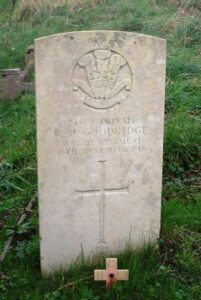
Cyril Norman Green, Driver, 122243, Royal Field Artillery. Cyril was the son of John and Bessie Rundle Green. He had resided at Mount Pleasant, Tenby for several years prior to the war, and had been educated at Greenhill School. Cyril was living at 7, Bridge Street, Haverfordwest when he enlisted into the Royal Field Artillery, and was posted to France at sometime in 1916, joining their 55th Division Ammunition Column, which was attached to the 55th (West Lancashire) Division. The Division had fought throughout the Somme offensive in 1916, before relieving the 29th Division in the Ypres salient in October 1916. It was destined to remain in this area for almost a year, stationed near Railway Wood. Cyril was wounded at Railway Wood, and evacuated to the Military Hospital at Boulogne, where he died of his wounds on 11 March 1917. He was 21 years old, and is buried at Boulogne Eastern Cemetery, France.
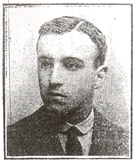
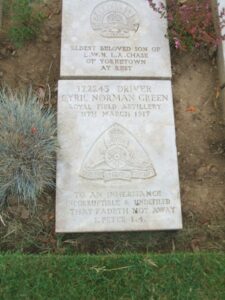
Ernest Atherton Gregory, Private, 27244, Kings Shropshire Light Infantry. Ernest was born in 1898, the son of Ernest Arthur Gregory and Sarah Jane Gregory (nee Richards), of 9, Edward Street, Tenby. Ernest enlisted at Tenby into the Brecknockshire Battalion, South Wales Borderers, but later transferred into the 7th Battalion, King’s Shropshire Light Infantry, who were initially attached to 76 Brigade, 25th Division. The Battalion landed in France on 28 September 1915 and on 15 October moved with the Brigade to 3rd Division. They transferred to 8 Brigade, 3rd Division just four days later, remaining with them through the war, fighting at Ypres before moving to the Somme, where they fought throughout most of the actions in 1916. The Division then took part in the 1917 Arras Offensive, fighting at the Scarpe and Arleux, then moved to Ypres, and fought during Third Ypres at the Menin Road and Polygon Wood. In November they were on the move again, and fought at the Battle of Cambrai, and were in the area when it was hit by the German Spring Offensive of March 1918. They fought throughout 1918, and were taking part in the Battle of Albert when Ernest was killed in action on 23 August 1918, aged 19. He is buried at Douchy-Les-Ayette British Cemetery, France. Ernest is the man seated in the photograph.
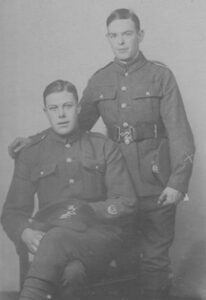
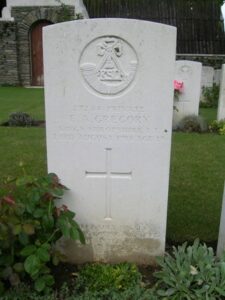
James Henry Harries, Private, 10475, Welsh Regiment. James was the son of Jacob and Maria Harries of 1, Chimney Park Back Row, Tenby. He lived at Neyland prior to the outbreak of war, and enlisted at Pembroke into the 1st Battalion, Welsh Regiment, which at the outbreak of war was in India on Garrison duties. The battalion was recalled to Britain at the outbreak of war, where it joined 84 Brigade, 28th Division. The Division formed in England between December 1914 and January 1915 from regular units returning from India, Singapore and Egypt. During January 1915 it moved to France, landing at Le Havre and moved to the Western Front, where it saw its first major action during the Second Battle of Ypres. The battalion suffered terrible casualties during horrific conditions here. Among the casualties was James, who was wounded at Ypres and evacuated to the 12th General Hospital at Boulogne for treatment. Sadly, he died of wounds there on 24 May 1915, aged 31, and is buried in Boulogne Eastern Cemetery, France.
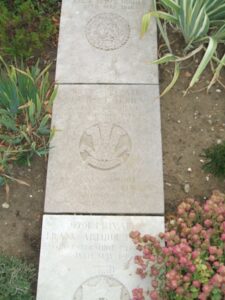
John Harries, Private, 8592, Welsh Regiment. John was born in Tenby, the son of Jacob and Maria Harris, and was the brother of James Henry Harries (above). He enlisted at Pembroke into the 2nd Battalion, Welsh Regiment, which was in Bordon in August, 1914 attached to 3 Brigade, 1st Division. The Division moved to France that month, and fought at the Battle of Mons, and in the epic retreat to the Marne, where the German attack was halted. The Germans withdrew to the Aisne to regroup, and the BEF met them there, during the Battle of the Aisne, where the advance on Paris was halted. Moving to Ypres, the Division fought at First Ypres, where they stopped the German advance toward the Channel Coast, and saved the ancient City of Ypres from capture, and then settled down to their first winter in Flanders. In 1915 they fought at Aubers, and later at Loos, and remained at Loos for the remainder of the year, and the beginning of 1916, until moving to the Somme, where they fought throughout the Offensive there from July onwards. In March, 1917 they followed the German retreat to the Hindenburg Line, and moved to the Belgian Coast in the summer, where they prepared for an offensive there, but the offensive was cancelled due to the stagnation of the attack at Ypres. John became ill during this time and was hospitalised at the 36th Casualty Clearing Station, where he underwent an operation to remove a tumour. He died there on 8 September 1917, aged 32, and is buried in Zuydcoote Military Cemetery, Belgium.
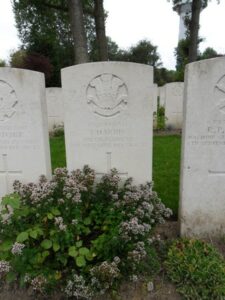
Frank Harris, Private, 208162, Nott’s & Derby (Sherwood Foresters). Frank was born in Shrewsbury, but prior to the war resided at 18, Culver Park, Tenby with his wife, Mary A Harris. He returned to Shrewsbury in December 1915 to enlist in the King’s Shropshire Light Infantry. Frank then served with the Machine Gun Corps, before being transferred to the 15th Battalion, Sherwood Foresters on 9 April 1918. The battalion was in France attached to 139 Brigade, 46th (North Midland) Division, and was in positions near Wytschaet. In the summer of 1918 the division moved south to the Somme area, and gained themselves immortality during the Battle of the St. Quentin Canal, when 137 Brigade stormed and captured Riqueval Bridge, thus breaking the Hindenburg Line. From here on the Germans were in disarray, and the Division pursued them towards Cambrai, and toward the River Selle, where Frank was Killed in action on 20 October 1918, aged 35. He is buried in Vichte Military Cemetery, France.
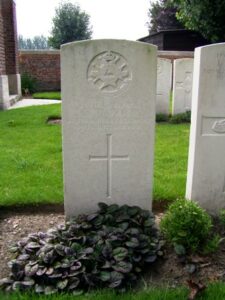
John Plunkett Verney Hawksley, DSO, MID, Lieutenant-Colonel, Royal Field Artillery. John was the son of James Taylor Hawksley and Emily Julia Hawksley, of Caldy Island. John was a career soldier, and had served in the South African and Sudan Campaigns (South Kordofan, 1910), before being awarded the temporary rank of Major at the outbreak of the Great War. After seeing action with the 32nd Brigade RFA from Mons to the Marne in 1914, John fought through 1915, and in March 1916 was promoted to Lieutenant-Colonel in command of 110th Brigade, Royal Field Artillery, attached to 25th Division. John had a distinguished career, gaining him the Distinguished Service Order, was three times Mentioned in Despatches and was the holder of the Order of the Osmanieh (4th Class) (awarded while attached to the Egyptian Army), but was sadly killed in action on the Somme on 8 August 1916, aged 38. He is buried at Becourt Military Cemetery, Becordel-Becourt, France.
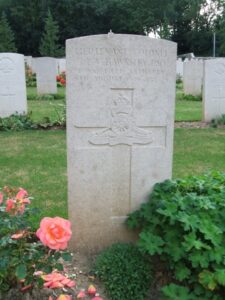
Henry May Henderson, MID, Lieutenant-Colonel, Royal Engineers. Henry was born on 31 December 1879, the son of Captain John Hannam Henderson, R.N., and Betsy Ann Henderson (nee May), of Red House, Tenby. He was the nephew of Admirals William, Sir Reginald and Frank Hannam Henderson. Henry obtained his commission in January 1899, and served with the 13th Field Company during thee Boer War. He remained in the Royal Engineers after the Boer War, steadily making his way through the ranks, and was with the BEF in France when war broke out. He was wounded on 15 September 1914, during the Battle of the Aisne, and sent home to recuperate. On his recovery he was posted to the Royal Military Academy, Sandhurst as Chief Instructor in Military Engineering, and remained there until being sent to the front again in March 1916 as Major in charge of a Field Company, attached to the 18th Division. He was wounded again on 9 July, during the opening phase of the Somme Offensive, but remained in France, and was promoted Lieutenant Colonel in January 1917, and appointed Commanding R.E. of the 18th Division. Henry was also Mentioned in Despatches on 4 January. Sadly Henry was Killed in action on the Somme on 10 March 1917, aged 38. He is buried in Aveluy Communal Cemetery Extension, France.
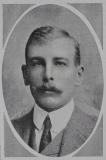

Thomas John Hodges, Gunner, 229058, Royal Field Artillery. Thomas was the son of John and Julia Hodges. He married Mary Naomi Beatley in 1913, and Mary later resided at 28, Harries Street, Tenby. Thomas served with the 9th Reserve Battery, Royal Field Artillery, and sadly died at Fulwood Military Hospital, Preston on 21 May 1917, aged 39. He is buried at Coddington (All Saints) Churchyard, Herefordshire. Thomas is not commemorated at Tenby.
William Hodgson, Leading Cooks Mate, 347770, Royal Navy. William was born at Tenby on 18 May 1888, the son of Harriet Hodgson, and the Brother of Mrs. Ellen Thomas, of Mayfield, Longstone, Stepaside. He was a regular in the Royal Navy, serving aboard H.M.S. Goliath, which was a Canopus Class Battleship, which had been mothballed in 1913, joining the Pembroke Reserve at Pembroke Dockyard When war broke out, Goliath was sent to the East Indies, and undertook operations there against the Konigsberg. On 25 April 1915 the invasion of the Dardanelles took place. Goliath was one of the huge armada of ancient warships that the Royal Navy sent to offer artillery cover to the landing force, and she remained there, playing a vital role in firing her huge guns at the Turkish positions on the Peninsula, but her time was drawing to a close. On 13 May 1915 Goliath was hit by a torpedo from the Turkish torpedo boat Muavanet, and rapidly capsized and sank, taking 570 of her crew to the bottom. William was one of the men who died that day. He was 26 years old, and is commemorated on the Plymouth Naval Memorial, Devon.
Charles William Howells, Seaman, 2444A, Royal Naval Reserve. Charles was born on 9 September 1891, the son of Thomas and Annie Louisa Howells, of 3, St. Mary’s Street, Tenby. He served with the Royal Naval Volunteer Reserve aboard the S.S. Trenta-y-Tres, but died of sickness at Uruguay on 4 January 1919, aged 26. He is buried at Buceo British Cemetery, Montevideo, Argentina.
Reverend John Wesley Howells, Second Lieutenant, Lancashire Fusiliers. John was born on 26 October 1887, the son of William and Sarah Jane Howells, of Arch House, St. George Street, Tenby. He was educated at Tenby, before training at Westminster, becoming a Wesleyan Minister at Manchester prior to the war. John enlisted on 14 May 1915, and was commissioned in August that year into the 7th Battalion, Lancashire Fusiliers. The Battalion was formed in Salford in August, 1914, as part of the East Lancashire Division, and had been in Egypt since 25 September 1914, being landed on Gallipoli on 5 May 1915. John joined the Battalion when it had returned to Egypt from Gallipoli, but soon transferred to the Royal Flying Corps, training as an Observer, attached to 14 Squadron, RFC. On 23 July 1917, John was flying as Observer to Lieutenant R. N. Thomas, in their BE2e, when it suffered a direct hit by anti-aircraft fire, South-West of Gaza, Palestine. Both men were killed when the aeroplane crashed into the sea. Both John and his Pilot are commemorated on the Jerusalem Memorial, Israel.
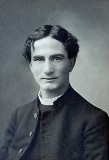
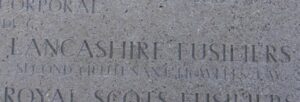
George Waldeof Huntington, Lieutenant, Kings Royal Rifle Corps. George was the son of Thomas and Florence Ellen Huntington, of Norwich, Connecticut, U.S.A. He joined the Ceylon Contingent at the outbreak of war in August 1914, and served at Gallipoli and in Egypt before being commissioned into the 6th Battalion, King’s Royal Rifle Corps. He was posted to their 8th Battalion, which was attached to 41 Brigade, 14th (Light) Division on the Western Front. George hadn’t been long in France when he was killed in action during the Battle of Bazentin, on 24 August 1916. He was 32 years old, and is commemorated on the Thiepval Memorial, France.
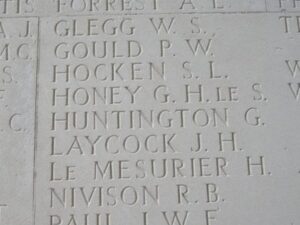
Nigel Jocelin Searancke Huntington, Second Lieutenant, Lincolnshire Regiment. Nigel was the son of Major Herbert Huntington and Alice Elizabeth Huntington, of The Rangers, Dursley, Gloucs. He had been commissioned into the Lincolnshire Regiment on 22 July 1914, and was posted to their 2nd Battalion, which was in Bermuda before moving to Halifax, Nova Scotia. The battalion returned to England on 3 October 1914 and on arrival became attached to 25 Brigade, 8th Division. On 6 November 1914 the battalion landed at Le Havre, and moved into positions near Festubert. Nigel was sadly killed just a week later, on 17 November 1914. He was 22 years old, and is commemorated on the Le Touret Memorial, Richebourg L’Avoue, France.
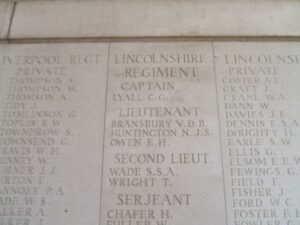
William Henry Hurley, Gunner, 463, Royal Garrison Artillery. William was born at Swansea in 1892, the son of Thomas James Hurley and Mary Ann Hurley (nee Jones). Mary was from Tenby, and by 1901 the family had moved back to Tenby, residing at St. Domingo Place. William was residing at Tenby at the outbreak of war, and had enlisted into the Pembrokeshire Battery, Royal Garrison Artillery on 11 August 1913. His mother had been widowed, and had moved to 1, Arcade Terrace, Garnant, Carmarthenshire. William didn’t serve overseas, but died of meningitis at Pembroke Dock Military Hospital on 27 May 1915, aged 23. He is buried at Pembroke Dock Military Cemetery.
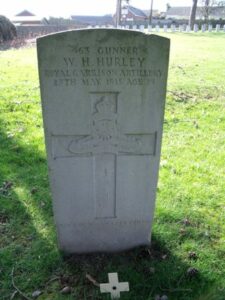
Robert John Fitzgerald Ingham, DSO, Lieutenant-Colonel, Royal Garrison Artillery. Robert was the son of Judge Robert Wood Ingham and Mary Elizabeth Ingham, of Sugwas, Hereford, and the husband of Ella Ingham, of Glebe Farm, Shackleford, Godalming, Surrey, and of Tenby. He was commissioned into the Royal Garrison Artillery on 22 November 1899, and embarked for France in 1915. Robert was awarded the Distinguished Service Order for the Somme offensive, before moving to Ypres with the 58th Heavy Artillery Group, Royal Garrison Artillery. He was mortally wounded at Ypres, and died at Remy Sidings Casualty Clearing Station on 1 July 1917, aged 36. Robert is buried at Lijssenthoek Military Cemetery, Belgium. Robert’s son, John Oliver Ingham, was killed during WW2. Neither man is commemorated at Tenby.
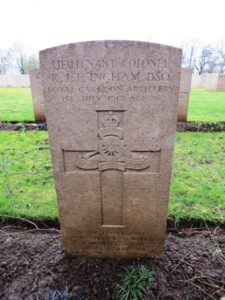
Charles Jeffries, Private, 1633, Welsh Guards. Charles was born Charles Robert Jeffery at Tenby in 1891, the son of John and Elizabeth Jeffery. He married Miriam Morgans at Pontypridd on 7 November 1912, and the couple resided at 72, Middle Street, Pontypridd, where they brought up two children. Charles enlisted on 2 November 1914 into the Royal Garrison Artillery, but was discharged after three months service as being ‘not likely to become an efficient soldier’. Charles re-enlisted at Porth into the 1st Battalion, Welsh Guards. The Welsh Guards were raised after the Royal Warrant 26 February 1915. After being formed, they became part of 3rd Guards Brigade, Guards Division, which was formed in France in August 1915. Their first taste of battle was at Loos, before being brought south to the Somme in 1916. During the Somme Offensive the Division fought at the Battle of Flers-Courcelette, and at Morval, and followed the German withdrawal to the Hindenburg Line in March, 1917. Their next major action was during the offensive of Third Ypres, where Charles fought with the Welsh Guards at the Battle of Pilckem. They moved to positions near the Menin Road, where Charles was killed in action on 4 September 1917, aged 27. He is commemorated on the Tyne Cot Memorial, Belgium.
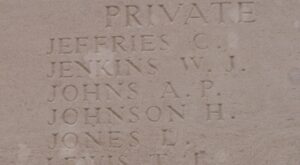
Archibald Thomas Wimbourne Jenkins, Private, 19086, Army Pay Corps. Archibald was born on 7 July 1895, the son of William and Martha Annie Jenkins, of 29, Norton, Tenby. He worked as a draper at Tenby prior to enlisting into the army and was posted to the Army Pay Corps, Detachment No. 1, at Shrewsbury. Archibald drowned during a tragic boating accident at Shrewsbury on the evening of Sunday, 28 April 1918, aged 22. His remains were recovered from the river and brought home for burial in St. Mary’s Church Cemetery, Tenby on 4 May.
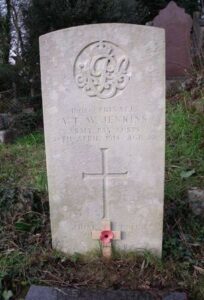
Leoline Jenkins, DSO, MC and Bar, Lieutenant-Colonel, Royal Air Force. Leoline was born at Plymouth on 3 May 1891, the son of Leo and Maud Jenkins. The family was from Tenby, but resided at Ecclesfield, Ashford, Middx. Leoline had originally been commissioned into the Dorsetshire Royal Garrison Artillery on 15 February 1911, and by the outbreak of war was a Captain. Leoline was awarded the Military Cross for bravery early in 1916, and transferred to the Royal Flying Corps, earning his pilot’s license on 6 July 1915, before being posted to 15 Squadron. He won a Bar to his MC later in the war, his citation reading; ‘For conspicuous gallantry and skill. He has done much fine work for the artillery, often under very difficult circumstances. On one occasion he flew for a long time at a very low altitude under continual machine-gun and artillery fire.’ By then Leoline had been promoted to Lieutenant-Colonel, and was attached to South Eastern H.Q. He was also awarded the Distinguished Service Order, but sadly died at Millbank Military Hospital on 20 November 1918, aged just 27. He is buried at Acton Cemetery, England.
Arthur Morgan John, Private, 33698, Royal Warwickshire Regiment. Arthur was born in Saundersfoot, the son of William and Mary John. The family later resided at Oxford House, Lower Frog Street, Tenby. Arthur enlisted at Neath into the Army Service Corps, but later transferred into the 1/8th Battalion, Royal Warwickshire Regiment, which was attached to 75 Brigade, 25th Division. The Battalion had originally been part of 143 Brigade, 48th Division, and had first landed in France on 22 March 1915. They fought on the Western Front until moving to Italy during November 1917, and after two years there on the Italian Front, they returned to France, moving back from Italy on 19 September 1918, to take part in the final advance. Arthur was killed in action during the Battle of the Selle on 10 October 1918, aged 23, and is buried at Maurois Communal Cemetery, France.
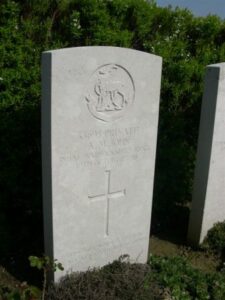
William John, Private, 55464, Royal Welsh Fusiliers. William was born at Tenby on 6 August 1883, the son of William John and Margaret John (nee Phillips), of Laugharne. He married Martha Elizabeth Davies in 1908, and the couple raised four children, at 29, Victoria Street, Tenby. William enlisted at Tenby into the Pembroke Yeomanry, but later transferred into the 16th Battalion, Royal Welsh Fusiliers, part of 113 Brigade, 38th (Welsh Division). The Division embarked at Folkestone on 5 December 1915, disembarking at Boulogne the same day. During the winter and spring of 1916 the Battalion held the line in the Armentières sector, and at the end of May, 1916 moved South with the remainder of the 38th (Welsh) Division to the Somme area, in readiness for the First Battle of The Somme. The 38th Division was tasked with the taking of the infamous Mametz Wood, with the first attack going in on 7 July, when the division lost heavily in ‘Death Valley’ during the advance on the ‘Hammer Head’. The next attack went in on 10 July and by 12 July the wood was cleared. Due to the terrible casualties taken by the Division during the capture of Mametz Wood, they were removed from the front, and posted to Ypres to rebuild. William was sadly killed in action during that first winter at Ypres, on 15 January 1917, aged 33. He is buried at Essex Farm Cemetery, Belgium.
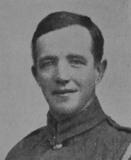
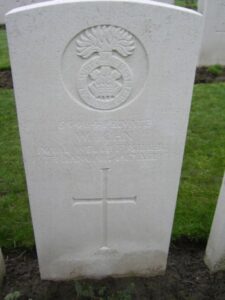
Frank Thomas Jones, Private, 10732, Machine Gun Corps. Frank was born at Tenby, the son of Henry and Elizabeth Jones, of 3, Marsh Road, Tenby. He had initially enlisted at Burry Port into the Royal Welsh Fusiliers, but later transferred into the 33rd Battalion, Machine Gun Corps, which were attached to the 33rd Division. The Division had been in France since December, 1915. They had fought throughout the Battles of the Somme, and during the Arras Offensive and at Third Ypres, and were in Flanders when the German Spring Offensive of 1918 hit the area. The Division fought during the desperate following few months, and moved to the Somme in September, 1918, and were taking part in the advance on the Hindenburg Line, prior to the Battle of the St. Quentin Canal, when Frank was wounded. He sadly died of wounds on 21 September 1918, aged 21, and is buried at Villers Hill British Cemetery, Villers-Guislain, France.
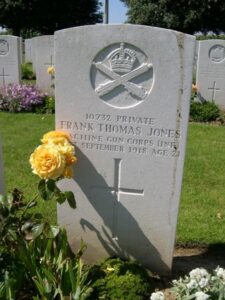
James Arthur Jones, Chief Stoker, 300369 (Dev), Royal Navy. James was born at Llangenny, Breconshire on 21 August 1882, the son of William and Sarah Jones. His parents later moved to 1, Upper Park Road, Tenby, while James found work with the Great Western Railway at Nantyglo. He enlisted into the Royal Navy on 16 April 1902, and was firstly based at HMS Pembroke II, which was based at RNAS Eastchurch, Sheppey, Kent. He had various postings during the coming years, then in 1915 was posted to HMS Vivid II, the RN base at Devonport. James became ill whilst attached to HMS Hecla, and died of pneumonia at Chester Military Hospital on 15 November 1918 aged 36. He is buried at Tenby (St. Mary) Church Cemetery.
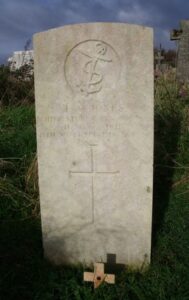
James Arthur Jones, MID, Captain, South Wales Borderers. James was the son of the Reverend James Jones (late Vicar of Llandebie) and of Mrs. Jane Jones, of Hill Cottage, Heywood Lane, Tenby. He served in the 10th Battalion, South Wales Borderers, part of 115 Brigade, 38th (Welsh) Division. In the summer of 1915 the Battalion moved with the remainder of the Welsh Division to Morn Hill Camp, Winchester, where it completed its training and equipping, and embarked for France from Folkestone on 5 December 1915, disembarking at Boulogne the same day. During the winter and spring of 1916 the Battalion held the line in French Flanders, and then moved south to the Somme, where they fought at Mametz Wood. After a year in reserve, they fought at Pilckem Ridge and Langemarck in Third Ypres, and were back on the Somme in 1918 facing the German Offensive. After playing a leading role in pushing the Germans back in late 1918, James was killed in action on 8 October 1918 during the Battle of Cambrai. He is buried in Guizancourt Farm Cemetery, Gouy, France.
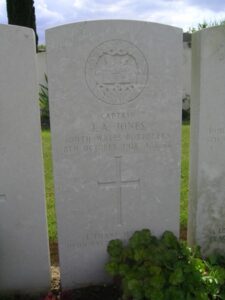
William Henry Jones, Private, 271, Royal Munster Fusiliers. William was born at Lisverry and lived at Tenby prior to the war. He enlisted at Newport, Monmouth into the Army, and was posted to the 1st Battalion, Royal Munster Fusiliers, part of 47 Brigade, 16th (Irish) Division. During December 1915 the Division moved to France and concentrated in the Bethune area. They saw their first major action during the Somme Offensive, at the Battle of Guillemont, and also fought at the Battle of Ginchy. By May 1917 the Division had moved to positions south of Ypres, where they fought at the Battle of Messines, and then moved north, fighting at the Battle of Langemarck. At the beginning of 1917 the Division was stationed near St. Quentin. They were hit here by the German Spring Offensive of 21 March 1918, and took part in the Battle of St Quentin, and then at the Battle of Rosieres. William was killed during the dramatic fighting here on 22 March 1918. He has no known grave and is commemorated on the Pozières Memorial, France.
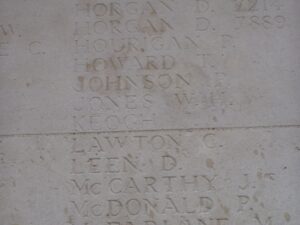
Henry Edwin Hunter Kent, Lieutenant, Rifle Brigade. Henry was the son of Captain Hunter Kent, R.N., and of Annie Kent, and resided at The Croft, Tenby. He was commissioned into the 22nd Battalion, Rifle Brigade, which was given the title ‘Wessex and Welsh’ Battalion, and was attached to 228 Brigade, 28th Division. The Division formed in England between December 1914 and January 1915 from regular units returning from India, Singapore and Egypt. During January 1915 it moved to France, landing at Le Havre and moved to the Western Front, where it saw its first major action during the Second Battle of Ypres. The Division then fought at the Battle of Loos. During October 1915, the Division embarked at Marseilles, and proceeded to Egypt, and in November moved on to Salonika where the Division then remained. The efforts of fighting the war in the malaria ridden countryside of Salonika proved too much for Henry though, and he died of its effects on 16 November 1922, aged 57. Henry is commemorated on a brass plaque sited within St. Mary’s Church, but is not on the Tenby War Memorial.
Donald Kenworthy, Captain, Somerset Light Infantry. Donald was born at Tenby in 1888, the son of John and Mary H. Kenworthy, of Tenby. Donald was the youngest of five sons who served during the Great War, and was one of two that died. He was educated at St. Andrews School Tenby and then at Cheltenham College. After graduating from Cheltenham he enrolled at Sandhurst and was gazetted Second Lieutenant in the 2nd Battalion, Somerset Light Infantry on 19 September 1908, serving with them at Malta, Tientsin and Quetta. In 1911 Donald passed through the Signalling School at Aldershot and was promoted to full Lieutenant. By the time was had broken out, Donald was a Captain, serving with the 1st Battalion, Somerset Light Infantry. The Battalion were stationed at Colchester as part of 11 Brigade, 4th Division, and they arrived in France in time to join II Corps at the Battle of Le Cateau. They took part in the epic fighting retreat to the Marne where the German Offensive was held, and then helped push the Germans back to the Aisne before being moved to Flanders. Here the Division fought at First Ypres, at the Battle of Messines on 12 October, and held the lines at Ploegsteert Wood during the famous Christmas Truce of 1914. On 22 April 1915 the Germans attacked Ypres again, and the Division fought through the battles of Second Ypres, which is when Donald was Killed in action on 17 May 1915, aged 27. He is buried at New Irish Farm Cemetery, Belgium.
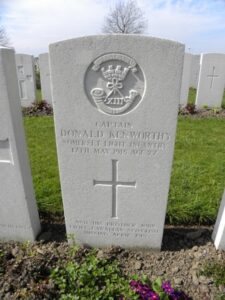
John Gibson Kenworthy, Lieutenant, Canadian Infantry. John was born in Hurst, Lancashire on 27 August 1881, the son of John and Mary H. Kenworthy, of Tenby, and the elder brother of Donald. He had emigrated to Canada with his wife Iris John Kenworthy, and they set up home there. John had already had 10 years service with the Lancashire Fusiliers in the British Army, and when he enlisted at Valcartier on 7 September 1914 into the 16th (Canadian Scottish) Battalion (Manitoba Regiment) he was commissioned as Lieutenant straight away, and sent to England, arriving on 14 October 1914. The Battalion was attached to the 3rd Canadian Brigade, 1st Canadian Division at Salisbury Plain and during February 1915 moved to the Western Front, taking up positions at Ypres. The Germans renewed their attacks on Ypres on 22 April 1915 with the release of 168 tons of Chlorine Gas on a 4 mile front held by French Colonial Troops at Gravenstafel, killing around 6,000 men in the first ten minutes. The line broke, and the 1st Canadian Division were rushed into the line, becoming embroiled in the terrible Battle of Gravenstafel for the first two desperate days. On 24 April 1915 the Canadians were still in the line, desperately holding their positions at St. Julien, when John was reported as wounded in action. He was then posted as Missing, but sadly was found to have been killed in action that day. His body was never found due to the terrible state of the battlefield by that time, and so John is commemorated on the Ypres (Menin Gate) Memorial, Belgium.
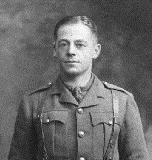
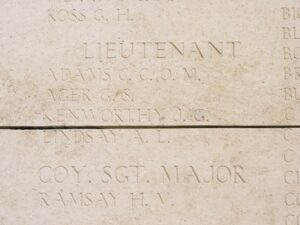
Ernest Herbert Kibblewhite, Sergeant, 7252, Wiltshire Regiment. Ernest was born on 6 December 1887, the son of William and Eliza Kibblewhite, of Station Road, Purton, Swindon. Ernest worked for the Great Western Railway prior to enlisting at Swindon into the Wiltshire Regiment. He was the husband of Rachel Mary Kibblewhite. At the outbreak of war, Ernest was posted to the 5th Battalion, Wiltshire Regiment, which was part of 40 Brigade, 13th (Western) Division. The division moved to Alexandria during June 1915. By 4 July, all units had moved to Mudros, preparatory for landing on Gallipoli. From 6 July 1915 the Divisional infantry landed on Cape Helles and relieved the 29th Division. They left and returned to Mudros at the end of the month, and the entire Division landed at ANZAC Cove between the 3rd and 5th August, 1915, taking part in the Battles of Sari Bair, Russell’s Top, and Hill 60. Ernest was killed in action during this period, on 10 August 1915, aged 27. He is commemorated on the Helles Memorial, Gallipoli. Rachel remarried in 1919, and resided at 20, Bryn Road, Neath.
Henry Kingston, Private, 54095, Royal Welsh Fusiliers. Henry was born at Blaengarw in 1895, the son of Albert Edward Kingston and Margaret Kingston (nee Jones). Margaret died in 1899, and Henry went to live with his Grandmother, Elizabeth Jones, at 15, Lower Saltern, Tenby, where he worked as an errand boy. His father had married Harriet Sarah Boyatt in 1900, and the couple had two children, residing at 26, Norton, Tenby. Henry enlisted at Neath into the 2nd Battalion, Royal Welsh Fusiliers. The battalion was used to plug holes in battle weary divisions during most of its time at war, and by the summer of 1916 was on the Somme, attached to 19 Brigade, 33rd Division. They saw action at High Wood and Longueval, and were still on the Somme when Henry was killed on 5 August 1916, aged 20. He has no known grave, and is commemorated on the Thiepval Memorial, France.
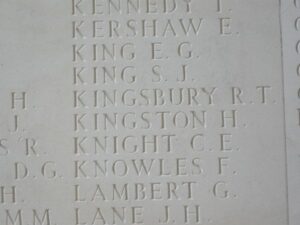
Francis John Dobree Knowling, MC, Captain, Argyll and Sutherland Highlanders. Francis was the younger son of Dr. Ernest Mansford and Helen Emily Hankey Knowling, of North Bay House, Tenby. He was educated at St. Andrews, Tenby and at Cheltenham College, and sat an Agricultural Course at Harper Adams College, Shropshire, which led to him being employed at Lord Rendlesham’s Estate in Suffolk. When war broke out, Francis enlisted in the Kings Shropshire Light Infantry, and on 22 September 1914 was commissioned into the Argyll and Sutherland Highlanders, and was posted to their 10th Battalion, attached to 27 Brigade, 9th (Scottish) Division. He moved to France with the Division in May 1915, and they fought at the Battle of Loos in September, where Francis was gazetted Captain, and was awarded the Military Cross for distinguished service in the field during June 1916. The Division were now at the Somme, and fought through most of the Somme Offensive, as well as the March 1917 Arras Offensive and at Third Ypres and the Battle of Cambrai. At sometime in 1917 Francis was wounded whilst serving on the Staff at Brigade Headquarters. After six months recuperating at home, he was passed fit for Home Service and was attached to an Officer Cadet Battalion at Crookham, Fleet as an Instructor but he must have become bored, and in January 1918 volunteered to return to his old Battalion at the front. Sadly Francis was soon killed in action, on 8 March 1918, aged 26. He is buried at Canada Farm Cemetery, Belgium.
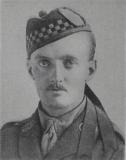
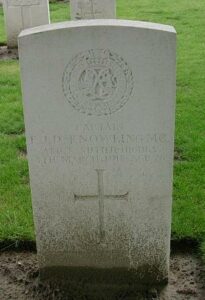
Edward Lucien Laws, Trooper, 501, East African Mounted Rifles. Edward was born in Tenby in 1876, the son of Edward and Georgina Elizabeth Laws (nee Nantes), of Brython, Tenby. His father was the son of Admiral John Milligen Laws, and had been High Sheriff of Pembrokeshire from 1899. Edward was educated at St. Andrews College, Bradfield, and resided at Brython, Tenby prior to the war. Edward was a businessman, and was declared bankrupt on 29 March 1909. He joined the East African Mounted Rifles, but took ill on active service, and died at Mombasa on 7 September 1916. Edward was 39 years old. He is probably buried at Mombasa (Mbaraki) Cemetery, but is not commemorated by the CWGC, so this cannot be verified.
Arthur Henry Ormond Lea, Lance Corporal, 6491, Honourable Artillery Company. Arthur was born on 24 January 1887, the only son of Henry and Elizabeth Lea, of Holmlea, Tenby. He had worked for the Great Western Railway’s as a Clerk at Paddington for many years prior to the war, and enlisted at Armoury House on 7 December 1915 into the 2nd Battalion, Honourable Artillery Company. The Battalion had been formed at Finsbury in August 1914 and on 3 October 1916 moved to France and joined 22 Brigade, 7th Division. The Division had just come through the Somme Battles, and spent the winter in the area, before following the German withdrawal to the Hindenburg Line in March 1917, where they got caught up in the fighting around Bullecourt, where they fought alongside the Australian Corps. Later that year they moved north, and fought throughout the Battles of Third Ypres, where they suffered terrible casualties in the awful conditions there. They were relieved from positions near Polygon Wood on 26 October 1917 and immediately moved to Italy, in support of the Italian Army. On 23 October the Division fought at the Battle of Vittorio Veneto, and Arthur was killed here on 26 October 1918, aged 31. He is buried at Tezze British Cemetery, Italy.
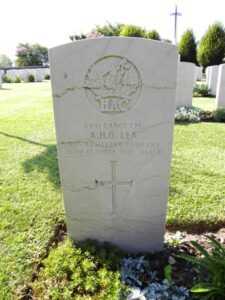
William Lea, Private, 29011, South Wales Borderers. William was born at Knighton, Radnor in 1887. He was working at Tenby by 1911, and married Alice Day, a Parlourmaid from Saundersfoot in 1911. The couple resided at 1, Elm Cottage, St. John’s Hill, Tenby. William enlisted at Brecon, and served with the 2nd Battalion, South Wales Borderers. The battalion had begun the war at Tientsin, China, where they defeated a German Force and captured the Island, before being recalled home, and had fought at Gallipoli attached to 87 Brigade, 29th Division during 1915. The Division was then sent to France, landing at Marseilles on 29 March 1916, and they remained on the Western Front for the duration of the war. The Division saw their first action on the Somme, during the attack on Beaumont Hamel. They remained on the Somme until after the Ancre Battles had ground to a halt at the end of 1916, and moved to Arras, where they fought at the Scarpe. Later that year, they moved to Ypres, and fought at Third Ypres, from Langemarck to Poelcappelle, and then saw further action at the end of 1917 during the Battle of Cambrai. The Division were in Flanders in 1918 when the area was hit by the German Offensive, and fought at Estaires, Messines, Hazebrouck, Bailleul and Kemmel, before fighting in the final Battle of Ypres, when William was killed in action on 28 September 1918, aged 34. He is buried at Zantvoorde British Cemetery, Belgium.
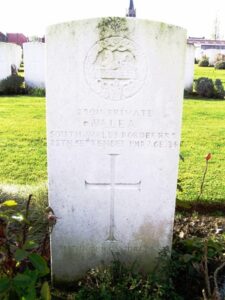
Alfred Leonard, Able Seaman, 207650, Royal Navy. Alfred was born at Tenby on 9 September 1884, the son of John and Mary Anne Leonard. He married Miriam Ward whilst based at Portsmouth with the Royal Navy in 1907. Alfred served aboard H.M.S. Good Hope. She was an old Drake Class Armoured Cruiser, which had been mothballed in 1913. She was quickly refitted for war, and joined the 6th Cruiser Squadron. Due to the belief that German Merchant Vessels were being converted into Armed ships, the Admiralty diverted Good Hope to reinforce Craddock’s force in the Atlantic, and she left Portsmouth on 2 August 1914 under the command of Captain Philip Francklin. Craddock transferred his flag to her on her arrival at Halifax, Nova Scotia because she was faster than his current flagship HMS Suffolk. For the next few weeks she was employed protecting British merchant shipping as far south as Pernambuco and later the Falkland Islands. She then embarked on the search for the German East Asiatic Squadron, leaving Stanley on 22 October for the west coast of South America via Cape Horn. She was sunk along with HMS Monmouth by the German armoured cruisers Scharnhorst and Gneisenau under Admiral Graf Maximilian von Spee with the loss of her entire complement of 900 hands, including Alfred, in the Battle of Coronel, on 1 November 1914, off the Chilean coast. Alfred was 30 years old, and is commemorated along with his ship-mates on the Portsmouth Naval Memorial, Hampshire.
Arthur Scott Lewis, Private, M/352041, Royal Army Service Corps. Arthur was the son of William and Alice Lewis, of Milford House, Tenby. Arthur and his wife, Maud Marie Lewis, had emigrated to Canada prior to the war, and lived at Spencer Creek Ranch, Cochrane, Alberta, Canada. Arthur had returned to Britain in 1917 to enlist at Carmarthen into the 604th Mechanical Transport Company, Royal Army Service Corps, but whilst in France during the terrible period of the German Offensive in Flanders, Arthur was pressed into action with the Royal Garrison Artillery, probably as a Driver. He was wounded during the Kaiserschlacht and Died of Wounds on 30 May 1918, aged 33. He is buried at Ebblinghem Military Cemetery, France.
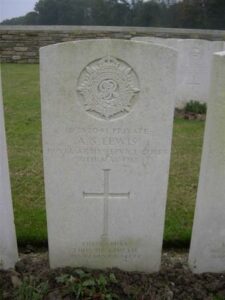
William Henry Lewis, Petty Officer 1st Class, 158928, Royal Navy. William was born at Pilton, Devon on 29 September 1875, the son of Edwin and Anne Lewis. He had resided at 24, Culver Park, Tenby for several years, working as a leading seaman, and was the husband of Martha Lewis, of 20a Hamoaze Avenue, St Budesux, Devonport, Devon. At the outbreak of war William served aboard H.M.S. Dublin, a Town Class Light Cruiser, which had been launched in April 1912. She had operated in the Mediterranean since, and at the end of September 1914 the Dublin was part of the squadron under Admiral Carden watching the Dardanelles. While the majority of British ships were soon replaced with French ships, the Dublin (along with the battle cruiser Indefatigable and three submarines) remained off the Dardanelles at the end of 1914. William died of disease aboard Dublin on 23 October 1914, aged 39. He was buried at sea, and is commemorated on the Plymouth Naval Memorial, Devon.
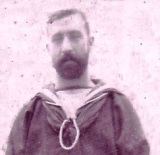
Thomas Henry Lillycrop, Seaman, 2470/A, Royal Navy. Thomas was born at Tenby on 25 September 1890, the son of Thomas Henry and Sarah Lillycrop, of Quay Hill, Tenby. The family were fishermen, and owned their own boat, the Gwendoline. Thomas married Naomi Waters in the winter of 1911, and the couple had a son, Gordon, who was born in 1917. After the outbreak of war, Thomas enlisted into the Royal Navy, along with his brother William John Lillycrop, and served at HMS Vivid, the base depot at Plymouth. Thomas sadly died as a result of his wartime service on 9 September 1918, aged 27. He is buried at Tenby (St. Mary) Church Cemetery.
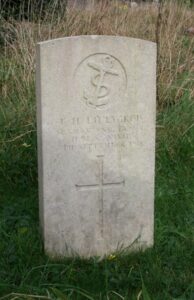
John William Llewellyn, Chief Petty Officer, 163981, Royal Navy. John was born at Tenby on 4 September 1875, the son of John and Rhosina Llewellyn. He married Mabel Louise Tucker prior to the war, and the couple resided at 25 Mount Street, Devonport. John served at H.M.S. Vivid, the Royal Naval Base at Plymouth, and died of sickness there on 10 February 1919. John was 42 years old, and is buried at Plymouth (Weston Mill) Cemetery, Devon. John is not commemorated at Tenby.
John Morris Philip Lloyd, Gunner, 371154, Royal Garrison Artillery. John was the son of Mrs. Mary Ann Lloyd of 19, St. Domingo Place, Tenby, and served with the 114th Siege Battery, Royal Garrison Artillery. John was serving on the Western Front during the Battle of Vimy Ridge, when he was killed in action on 24 April 1917. He is buried at Bois-Carre British Cemetery, Thelus, France. His brother William Henry Lloyd had died just two weeks earlier, less than two miles away.
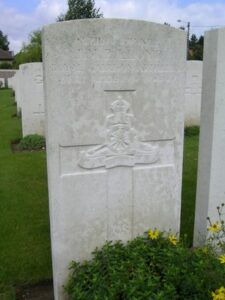
William Henry Lloyd, Private, 687387, Canadian Expeditionary Force. William was born at Tenby on 24 October 1892, the son of Mary Ann Lloyd, of 19, St. Domingo Place, Tenby. Prior to the war, William had emigrated to Canada, which is where he enlisted on 24 January 1916 into the 54th Battalion (Central Ontario), Canadian Infantry. The Battalion was attached to 11 Canadian Brigade, 4th Canadian Division, and the Division was formed in Britain during April 1916. They embarked for France in August that year, and saw their first major action during the end of the Somme Offensive at Le Transloy, and the Battle of the Ancre, where they captured Regina Trench. The following year the Division moved north above Arras, and took part in the Battle of Vimy, where the Canadian Corps successfully captured the heights of Vimy Ridge. William was Killed in action during the initial assault on 9 April 1917, aged 24, and is buried at Givenchy Road Canadian Cemetery, Neuville-St. Vaast, France. His brother died just two weeks later, about two miles away.
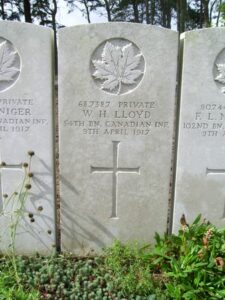
Arthur George Lord, Second Lieutenant, Royal Welsh Fusiliers. Arthur was the son of George and Phoebe Lord, of Fairfield, Tenby, and had been commissioned into the 3rd Battalion, Royal Welsh Fusiliers, which was a Reserve Battalion. He transferred into the 2nd Battalion, which had been on the Western Front since 11 August 1914. After fighting at the Battle of Loos, the Battalion transferred along with 19 Brigade to the 33rd Division, and they moved to the Somme area prior to the beginning of the great offensive on 1 July 1916, fighting at the Battles of Albert, and Bazentin, and at High Wood, where Arthur was Killed in action aged just 20, on 20 July 1916. His body was lost on the battlefields, and so he is commemorated on the Thiepval Memorial, France.
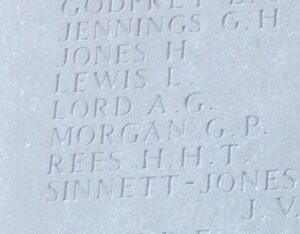
Henry Pierce Mackenzie, MID, Captain, Cameronians (Scottish Rifles). Henry was the son of Captain John and Charlotte Uppleby Mackenzie of Tenby. He was a merchant seaman prior to the war, and lived with his wife Jane Catherine Frances Mackenzie, at Kirkcudbright, Scotland. Henry was commissioned into the Cameronians, and served as Captain in the 9th Battalion, Cameronians, who were attached to 28 Brigade, 9th (Scottish) Division. The Division landed at Boulogne on 12 May 1915 and saw their first major action at the Battle of Loos. Henry was Killed in action during the first attack of the Battle on 25 September 1915, aged 37, and is buried at Cambrin Churchyard Extension, France. Henry is not commemorated at Tenby.
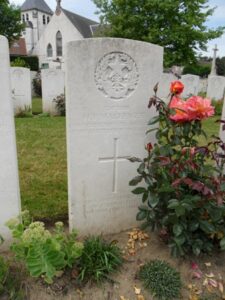
George Alderton Mallin (Served as Matthews), Private, 1343, Welsh Regiment. George was born at Birmingham in 1897. Prior to the war he lived with his grandparents, George and Jane Matthews, at 19, Lower Park Road, Tenby. George enlisted into the Welsh Regiment on 20 November 1913, under the name of Matthews. He was discharged from the army on 19 March 1914, after completing four months training, and returned home to 19, Lower Park Road, Tenby. George was mobilised on 8 August 1914, at the outbreak of war, and joined the 3rd (Reserve) Battalion, Welsh Regiment, at Cardiff. He was discharged on 27 April 1915 as being no longer physically fit for service, and died on 15 January 1917, aged 20. George is buried at Tenby (St. Mary) Church Cemetery.
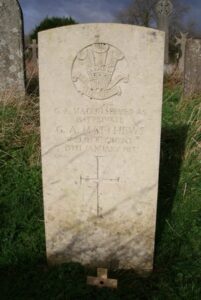
David Richard Mason, MID, Lieutenant-Commander, Royal Naval Reserve. David was born at Tenby on 28 November 1878, the son of Frank Britten Mason and Matilda Mason (nee Jones). He had been educated at the King Edward VI School, Norwich, and at the age of 14 was apprenticed to sea. He served on board the Steamship Ellisland from 1895 to 1899, and then as Second Officer on the Fleur-De-Lys on which he was promoted Chief Officer in 1900. On the outbreak of the Boer War, he returned to Wales and joined the Pembrokeshire Imperial Yeomanry, where he was promoted to Sergeant, and gained the Queen’s Medal with Five Clasps for service in South Africa. On returning home he entered into his father’s business, Frank B. Mason, Auctioneers, and in 1905 he married Selina Rachel Stanley-Johnson, the daughter of Thomas Stanley-Johnson and Mrs. Stanley-Johnson of Stanley House, Hereford. David returned to sea as Second Officer on the Steamship Emma of Cardiff, and then the Eddystone of London. David then entered the service of the Royal Mail Steam Packet Company, and by the outbreak of war had been promoted to Command of the R.M.S.P. Yare. In January 1915 he offered his services to the Admiralty and was given a temporary commission as Lieutenant. Again he worked his way up to Lieutenant-Commander, and was Mentioned in Despatches on 14 September 1917. By now David was serving aboard the H.M.S. Osmanieh. He was sadly killed on 31 December 1917 when Osmanieh struck a mine off Alexandria. He was 38 years old, and is buried in Alexandria (Hadra) War Memorial Cemetery, Egypt. He had left behind his bereaved wife, a son and a daughter.
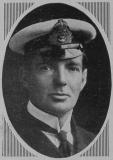
John William Augustus Mason, Sergeant, 313827, Royal Air Force. John was born at Bethnel Green in 1897. He was probably based at Pembroke with the Royal Naval Air Service early in the war, where he met, and married, Nora Winifred Williams, at Pembroke, in 1917. John served with the Royal Air Force during the Great War, and stayed in the services after the armistice. On 23 August 1921, John was a crewman aboard the newly built airship R38, which took off from Howden, Yorkshire. Due to bad weather, R38 remained in the air overnight, and set back to land at Howden the following day, carrying out manoeuvrability trials on the return journey. This proved to be fatal for the airship, as she broke up in mid-air, and crashed into the Humber, killing 44 of the 49 people aboard her. John was 27 years old when he died during the resulting crash, on 24 August 1921, and his body was returned to Pembrokeshire, where he was buried at Tenby (St. Mary) Church Cemetery. John is not commemorated at Tenby. Nora married Albert J. Saunders in 1923.
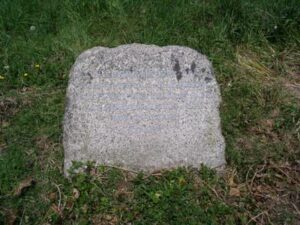
John Hamon Massy, Private, S/11606, Queen’s Own Cameron Highlanders. John was born at Tenby in 1879, the son of Haworth Peel Massy and Anne Justina Massy (nee Lloyd). He was residing at Worthing in Sussex prior to enlisting at Inverness into the 1st Battalion, Queen’s Own Cameron Highlanders on 1 June 1899. John had married either Annie Taylor or Mary Mayall whilst based near Brighton in 1911. His battalion formed for war at Edinburgh on 4 August 1914. Just ten days later they landed at Le Havre, and on 5 September were attached to 1 Brigade, 1st Division. The Division swiftly moved to Belgium, and fought in the Battle of Mons, and during the epic retreat to the Marne where the German advance was halted. The Germans pulled back to the Aisne, and the BEF met them there, fighting a battle which formulated the position of the Western Front for the duration of the war. The next move for the 1st Division was to Ypres, where they again helped stem the German advance, suffering terrible casualties, and they remained here for the first winter of the war, where John was Killed in action on 11 November 1914, aged 35. He is commemorated on the Ypres (Menin Gate) Memorial, Belgium. John is not commemorated at Tenby.
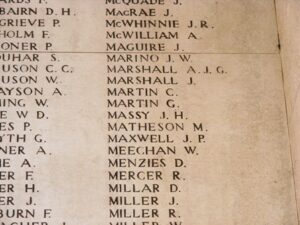
William Henry George Day Mathias, Lance Corporal, 18115, Royal Defence Corps. William was born at Bedwellty, the son of Anthony and Susan Mathias. The family had moved to Tenby by 1881, and William married there, residing with his wife Hannah Mathias, at Laurie Cottage, Tenby. He served with the Royal Defence Corps, in their 335th Protection Company. William died on 17 May 1917, aged 50, and is buried in Tenby (St. Mary) Church Cemetery.
Cecil George Mathie, Private, 24046, East Surrey Regiment. Cecil was born at Tenby, the son of William Clark Mathie and Edith Ruth Mathie (nee Hancock). The family later resided at 51, Nimrod Road, Streatham. Cecil was a Civil Servant, and married Gertrude Thorndyke, of 21, Credenhill Street, Mitcham Lane, Streatham, London on 2 April 1911. He enlisted at nearby Kingston-on-Thames into the 9th Battalion, East Surrey Regiment, which had been formed there during September 1914 and were attached to 72 Brigade, 24th Division. On 1 September 1915 the Division landed at Boulogne, and saw their first major action during the Battle of Loos. In July 1916 the Division moved to the Somme, and fought at Delville Wood and Guillemont. March 1917 saw them take part in the Battle of Vimy, alongside the Canadian Corps, and they also fought during Third Ypres, at the Battles of Messines, Pilckem and Langemarck. They were in the St. Quentin sector in early 1918 when Cecil was wounded. He Died of Wounds on 21 March 1918, aged 31, and is commemorated on the Pozieres Memorial, France. Cecil is not commemorated at Tenby.
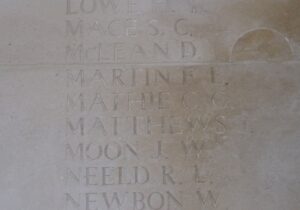
Charles Sidney Matthews, Able Seaman, 202510, Royal Navy. Charles was born on 1 May 1882, the son of George and Jane Matthews, of 19, Lower Park Road, Tenby. He enlisted on 1 May 1901, and served for the next twelve years on a variety of warships, including HMS Black Prince and HMS Defiance. In May 1913 he transferred to the Royal Fleet Reserve, and at the outbreak of the Great War served on HMS Jupiter, Severn, Vivid II, Defiance, Tarpow and Leander before being demobbed on 1 December 1919. There is no record of his death with the Commonwealth War Graves Commission, but he died in Pembrokeshire during September 1921, aged 39. Charles was buried at St. Mary’s Church Cemetery, Tenby on 23 September 1921. His brother George Matthews had died aerly in the war.
George Henry Matthews, Able Seaman, 194159, Royal Navy. George was born on 7 June 1881, the son of George and Jane Matthews, of 19, Lower Park Road, Tenby. He served in the Royal Navy aboard H.M.S. Mastiff, which was a Miranda Class Destroyer, which had been launched on 5 September 1914 and had served throughout the war with the Harwich Force. He died on 27 August 1915, aged 35, and is buried in Gillingham (Woodlands) Cemetery, Kent. His brother Charles Matthews died after the armistice.
James Percy May, Major, Indian Army. James was born at Honolulu on 3 October 1879, the son of Tom May and Julia Adelaide May (nee Wight). The family later resided at Red House Tenby. James served in the Indian Army, with the 102nd King Edward’s Own Grenadiers. When war broke out in August, 1914, the Battalion moved to German East Africa, and fought there for two years, before moving to Mesopotamia. James was serving with the Grenadiers in Mesopotamia when he was Killed in action on 12 February 1917, aged 37. He is buried at Amara War Cemetery, Iraq. He was a relative of John Hannam Henderson, R.N., who also fell.
William Herman Henry McGrath, Company Quartermaster Sergeant, 11949, South Wales Borderers. William was born at Salford, Lancashire, and was the Husband of Sarah McGrath, of St. George Street, Tenby. He enlisted at Pembroke Dock into the 2nd Battalion, South Wales Borderers, who were stationed at Tientsin, China at the outbreak of war. The SWB fought a German garrison at Tsingtao Island, and were then moved to Hong Kong, where they embarked on 4 December 1914 for England, landing at Plymouth on 12 January 1915. They joined 87 Brigade, 29th Division at Rugby soon after arriving home, and on 17 March the Division set sail for the Mediterranean, arriving at Alexandria on 29 March. From here the Division were landed as part of the first wave at Cape Helles, Gallipoli on 25 April 1915, and they fought throughout the abortive campaign here, where William was wounded and evacuated to a hospital ship anchored off shore. Sadly, William died of wounds aboard the ship on 30 August 1915, aged 45, and was buried at sea. He is commemorated on the Helles Memorial, Gallipoli.
William Fenn Miles, Leading Boatman, 157978, H.M. Coastguard. William was born at Shoreditch, Middlesex on 3 February 1875, the son of George and Emma Miles. He married Louisa Winterburn on 9 May 1905, and the couple resided at 2, Corsehill Street, Streatham, London. William served in His Majesty’s Coastguard, at HM Coastguard Station, Tenby. William died of disease on 31 October 1918, aged 43. William is buried at Tenby (St. Mary) Church Cemetery. William is not commemorated at Tenby.
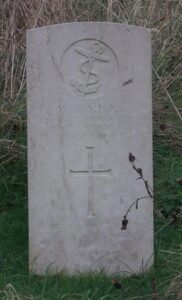
Jack Greville Moore, Lieutenant, Royal Air Force. Jack was born at Rangoon, the son of Walter Greville and Mary Beatrice Moore. His parents later resided at Morton Cottage, Tenby. Jack served with 81 Squadron, Royal Air Force, which had been formed on 7 January 1917 at Gosport as a Training Unit. Jack died at RAF Scampton on 2 April 1918, aged 19, possibly of the result of a training accident, and is buried at Lincoln (Newport) Cemetery. Jack is not commemorated at Tenby.
William George Maurice Morgan, Private, 50012, South Lancashire Regiment. William was born on 6 April 1892, the son of William and Mary Morgan, of Moysland Farm, New Hedges. He married Mary Stephens at Jeffreyston on 17 July 1915. William enlisted at Cardiff into the Army. He was posted to the 6th Battalion, South Lancashire Regiment, attached to 38 Brigade, 13th (Western) Division. The division had seen terrible fighting at Gallipoli before being evacuated to Egypt in January 1916. They then became attached to the Tigris Corps, and took part in the invasion of Mesopotamia. They fought a hard, disease-ridden campaign in Mesopotamia, which is where William was accidentally drowned on 10 November 1917, aged 25. He is buried at Baghdad (North Gate) War Cemetery, Iraq.
Edward Taylor Morley, Sapper, 89274, Royal Engineers. Edward was born at Tenby in 1877, the son of Henry and Mary Morley. He married prior to the war, and lived at York with his wife Louisa Morley, and their daughter Constance. Edward enlisted at York into the Royal Engineers, serving with their 70th Field Company. Edward was serving with his company in French Flanders when he was Killed in action on 8 June 1916, aged 38. He is buried at Mazingarbe Communal Cemetery Extension, France.
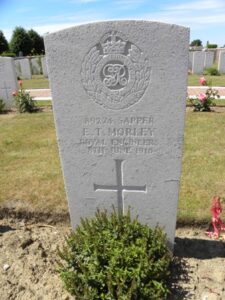
John Albert Morris, Petty Officer Stoker, 289538, Royal Navy. John was born on 25 March 1880, the son of Charles and Eliza Morris, of Franklyn House, Frog Street, Tenby. He had served in the Royal Navy for many years prior to the war, and his wife, Mary A Morris, resided at 38, St Lavans Road, Ford, Devonport, Devon. John served aboard the Battle Cruiser HMS Indefatigable. She was commissioned in February 1911 and joined the 1st Cruiser squadron. She joined the 2nd battle Cruisers squadron in the Mediterranean at the outbreak of world war one in August took part in the pursuit of Goeben and Breslau and also bombarded Cape Helles. She became the Flagship of Admiral Carden in November 1914 until January 1915. After a refit at Malta she joined the Grand Fleet as part of the 2nd battle Cruiser Squadron and was sunk at Jutland by 11 inch shell fire from Van Der Tann. Official reports state she was hit by two shells in the X magazine causing her stagger out of formation sinking by the stern this was followed by another hit on the foredeck causing a much larger explosion which destroyed her. John was killed when Indefatigable blew apart on 31 May 1916. He was 36 years old, and is commemorated on the Plymouth Naval Memorial, Devon.
James Murphy, Corporal, S/8610, Royal Army Ordnance Corps. James was the son of Peter and Sarah Elizabeth Murphy, of 16, Lower Saltern, Tenby. He married Lily Ethel Maud Price at Willesden on 19 June 1916, the daughter of George William Price, of 29, Kensal Road, Westbourne Park, London. James served with the 43rd Company, Royal Army Ordnance Corps, and sadly Died of Sickness after the Armistice, in Salonika on 21 December 1918, aged 24. He is buried at Mikra British Cemetery, Kalamaria.
Samuel Robert Nesbitt, Lance Corporal, 3/12065, South Wales Borderers. Samuel was born in Tenby in 1887, the son of Samuel Robert Nesbitt, a soldier from Liverpool, and Alice Ann Nesbitt (nee Jenkins), a domestic servant from Laugharne. Alice died just after Samuel’s birth, whilst his father died of pneumonia whilst based on Guernsey in 1889, leaving Samuel and his elder brother Joseph orphaned. With no surviving family left in Laugharne, Samuel and Joseph were raised by Thomas and Susan Williams in Tenby. By 1911 Samuel was working as a groom at The Heath, Cardiff, then by 1913 he had moved to 54, The Watton, Brecon, where he had found work as a groom. On 27 April 1913 Samuel married Lilian Rose Eldred of Brecon and the couple had two daughters over the coming years. Samuel enlisted into the South Wales Borderers at Brecon on 28 October 1914, stating that he had four years prior service with the Pembroke Yeomanry, and was initially posted to the 3rd Battalion, South Wales Borderers. On 20 September 1915 he was posted to the 50th Provisional Battalion, then on 30 December 1916 was drafted to France, joining the 2nd Battalion, South Wales Borderers, which was on the Somme, attached to 87 Brigade, 29th Division. Within weeks of his arrival, Samuel was hospitalised, suffering from scabies and eczema, commonplace in the trenches, and by the time he rejoined the battalion, the division had moved to the Arras sector. Samuel would have then taken part in the ferocious assault carried out by the division against Monchy-Le-Preux, during the Battle of Arras, but soon afterwards scalded himself whilst cooking at the officers mess, during a brief respite out of the line. Samuel was treated at Arras before being sent to the 2nd Australian General Hospital at Wimereux, where he was found to be suffering from pthisis. He was sent back to England for treatment at a Military Hospital at Endells Street, London, but with no antibiotics available to cure his condition at that time, he was discharged from the army as medically unfit on 18 September 1917 and returned home to Brecon. Samuel’s health continued to deteriorate after being discharged and he died of pthisis at Brecon on 15 January 1921. The 35-year-old was buried in Brecon Cemetery. His widow, Lily, also lost her brother, Bertie Eldred in 1920, as a result of sickness contracted during the war. Samuel is not commemorated on the Tenby war memorial.
Harold Thomas Nicholls, Private, 36778, King’s Own (Royal Lancaster Regiment). Harold was born at Tenby in 1898, the son of Thomas Hugh and Edith Mary Annie Nicholls. The family had moved to Ardenne, Banstead Road, Belmont, Sutton prior to the war. Harold enlisted at Rhyl in December 1914 into the Welsh Regiment, and landed in France on 2 December 1915 with the 38th (Welsh) Division. He was later transferred to the 9th Battalion, King’s Own (Royal Lancaster Regiment), which was attached to 65 Brigade, 22nd Division. In September 1915 the Division landed in France, but were soon transferred to Salonika, landing on 7 November. Harold survived most of the campaign in Salonika, but was wounded during the Battle of Doiran, and Died of Wounds on 19 September 1918, aged just 20. He is buried at Karasouli Military Cemetery, Salonika.
William Harold Nicholls, Captain, Australian Infantry. William was born in Tenby in 1886, the son of William and Catherine Nicholls. He was the husband of Lilian May Nicholls, later of 3, Central Terrace, Llanbradach, Cardiff. William had emigrated to Australia prior to the war, and enlisted at Ipswich, Queensland on 21 September 1914 into the 15th Battalion, Australian Imperial Force. The 15th Battalion formed part of the 4th Australian Infantry Division, 4th Australian Infantry Brigade, and embarked at Melbourne on 22 December 1914 aboard His Majesty’s Australian Troopship Ceramic, bound for Egypt, where the Anzacs were readied for the Gallipoli campaign. The 4th Brigade landed at Anzac Cove, Gallipoli on the afternoon of 25 April 1915, and from May to August, the battalion was heavily involved in establishing and defending the ANZAC front line. William was commissioned to Second Lieutenant whilst at Gallipoli, on 18 August 1915. They remained here until December 1915 when they were evacuated off the Peninsula to Egypt. Here William was promoted to full Lieutenant, and the Australian Divisions guarded the Suez Canal for a while, before being moved to France in June 1916 where they took over a part of the line near Armentieres. The 4th Division soon moved south though, to accompany the 1st and 2nd Australian Divisions to the Somme, where they fought at Pozieres and Mouquet Farm, suffering terrible casualties for little gain. The Australians remained on the Somme for the winter of 1916/17, and during November William was promoted Captain. Sadly he was Killed in action soon after, on 26 January 1917, aged 29. He is buried at Guards’ Cemetery, Lesbouefs, France.
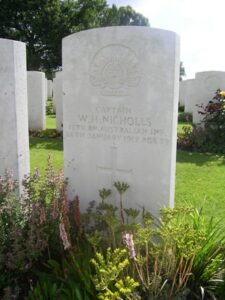
George Henry Nichols, Sergeant, 144838, Canadian Infantry. George was born in Tenby on 9 May 1884, the son of Richard Henry Wills Nichols and Elizabeth Ann Nichols (nee Beynon). The family later resided at 35, Huntingdon Road, Earlsdon, Coventry, but George emigrated to Canada. He enlisted in Canada into the 78th Battalion (Manitoba), which was attached to 12th Canadian Brigade, 4th Canadian Division, which had formed in Britain in April 1916. The Division moved to France in August, and saw their first major action on the Somme at Le Transloy and the Ancre, where they captured Regina Trench. In April 1917 they fought at the successful Battle of Vimy Ridge, north of Arras, and after another four months fighting in the area, moved to Ypres, where they fought in the Second Battle of Passchendaele. George was Killed in action at Passchendaele on 30 October 1917, aged 33, and is buried in Tyne Cot Cemetery, Belgium.
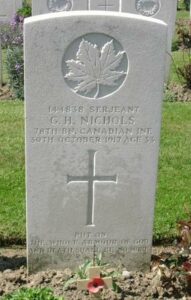
Richard Edwin Nock, Gunner, 371194, Royal Garrison Artillery. Richard was born in Newtown in 1895, the son of Richard Edwin nock and Maria Nock (nee Davies). By 1911 he was residing with his aunt and uncle, George and Elizabeth Davies, at Boston House, Tenby, where he was apprenticed to his uncle, who was a bootmaker. Richard enlisted at Hubberston Fort into the Pembrokeshire Battery, Royal Garrison Artillery. He was then posted to the 114th Siege Battery, Royal Garrison Artillery, which had been formed at Pembroke Dock on 8 March 1916 from members of the Pembrokeshire Royal Garrison Artillery. The Battery moved out to the Western front on 14 June 1916 equipped with four 6-inch Howitzers and initially joined the 32nd Heavy Artillery Group. By the time the Somme offensive opened on 1 July 1916 the 114th Siege Battery had been attached to the 28th HAG, joining the Fourth Army. The battery took part in the softening-up process during the Battle of Flers-Courcelette in September. The following year saw the 114th Siege Battery at Ypres, where it played a part in the Battle of Messines on 7 June 1917. Richard was killed by German counter-battery fire at Ypres on 24 June 1917, aged 22. He is buried at Belgian Battery Corner Cemetery, Belgium.
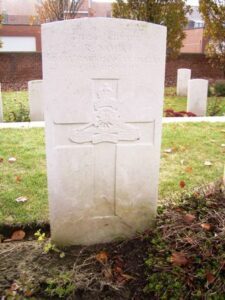
Philip John Norrish, Leading Seaman, J/1379, Royal Navy. Johnny was born on 20 May 1892, the son of John and Caroline Norrish, of 32, Harris Street, Tenby. He joined the Royal Navy on 20 May 1910, and by 2 September 1913 had joined the crew of HMS Defence. Defence was a Cruiser had been built at Pembroke Dockyard, and launched on 24 April 1907. She served during the Great War as the Flagship of Rear Admiral Sir Robert Arbuthnot, leading the First Cruiser Squadron, and on 31 May 1916 was in the thick of the Battle of Jutland. Disaster struck her when she was closing in for the kill at high speed with the SMS Wiesbaden, as she became an easy target for the nearby German Battlecruisers, and she was hit by a salvo which blew up her magazine, and she sank almost immediately. Johnny was Killed in action with the loss of his ship during the Battle of Jutland, on 31 May 1915, aged 24, and is commemorated on the Plymouth Naval Memorial, Devon. Many thanks to Dianne Scorer for the photograph.
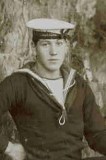
William Oakley, Sergeant, 608575, London Regiment. William was the son of Thomas and Sophie Oakley, of Cilfynydd. Thomas was originally from Pembroke, and Sophie was from Tenby, and the family regularly visited relatives at Tenby prior to the war. William resided at Bayswater at the outbreak of war, and enlisted in London into the 18th Battalion, London Regiment (London Irish Rifles). The battalion landed in France on 10 March 1915 attached to the 2nd London Division, and on 11 May 1915 its formation became 141 Brigade, 47th (2nd London) Division. The division fought at all of the major battles which followed, at Loos in September 1915, and on the Somme in 1916. During 1917 it fought at Messines, Passchendaele and at Cambrai, wintering on the Somme. In March 1918 the Division were situated near St. Quentin, and faced the German Spring Offensive here on 21 March, fighting at the Battle of St Quentin, and then in the rearguard action at the First Battle of Bapaume. William was killed on the Somme on 13 May 1918, aged 23. He is buried at Bouzincourt Ridge Cemetery, France. William is not commemorated at Tenby, but is commemorated on his parents grave at Tenby Church Cemetery.
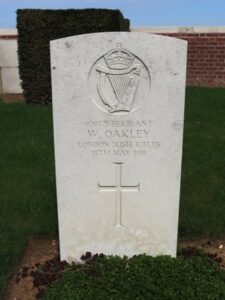
Arthur James Ormond, Private, 203034, South Lancashire Regiment. Arthur was the son of Richard and Martha Ormond, of 7, St. John’s Hill, Tenby. He enlisted at Pembroke Dock into the 2/4th Battalion, South Lancashire Regiment, which was formed in Warrington in September 1914. On 16 February 1917 the Battalion landed Boulogne as part of 172 Brigade, 57th Division, and moved to Flanders. Arthur was Killed in action only a few months later, on 8 May 1917, aged 24, and is buried at Erquinghem-Lys Churchyard Extension, France.
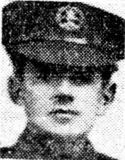
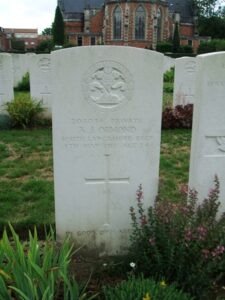
Charles Ormond, Engine Room Artificer 3rd Class, 271703, Royal Navy. Charles was born at Tenby on 23 January 1889, the son of John and Martha Ormond. Charles was educated at Tenby, before his parents moved to the Cambrian Hotel, Saundersfoot. Charles was a pre war regular in the Royal Navy, serving aboard HMS Defence. Defence was a Cruiser had been built at Pembroke Dockyard, and launched on 24 April 1907. She served during the Great War as the Flagship of Rear Admiral Sir Robert Arbuthnot, leading the First Cruiser Squadron, and on 31 May 1916 was in the thick of the Battle of Jutland. Disaster struck her when she was closing in for the kill at high speed with the SMS Wiesbaden, as she became an easy target for the nearby German Battlecruisers, and she was hit by a salvo which blew up her magazine, and she sank almost immediately. Charles was Killed in action with the loss of his ship during the Battle of Jutland, on 31 May 1915, aged 27, and is commemorated on the Plymouth Naval Memorial, Devon. Charles is not commemorated at Tenby.
William Ormond, Private, 11705, Welsh Regiment. William was born at Tenby around 1874, and prior to the war had resided at 69, Oxford Street, Mardy, Glamorgan. He enlisted at Tonypandy into the 8th Battalion, Welsh Regiment, which was formed at Cardiff during August 1914 as part of K.1. They were then attached to 40 Brigade, 13th Western Division. The Brigade assembled at Salisbury Plain, and then moved to Chiseldon and Cirencester in September 1914. Toward the end of February 1915, the entire Division concentrated at Blackdown in Hampshire, and in June 1915 sailed for the Mediterranean. On 4 July 1915 the Division landed on Cape Helles and relieved the 29th Division. From there, the Division took part in several actions, most notably The Battle of Sari Bair between 6-10 August 1915 and the Battle of Russell’s Top on 7 August 1915. William was wounded during the August battles, and evacuated to Egypt, where he sadly Died of Wounds on 25 August 1915, aged 41. He is buried at Alexandria (Chatby) Military and War Memorial Cemetery, Egypt. William is not commemorated at Tenby.
Bernard O’Toole, Sergeant, 78424, Tank Corps. Bernard was born in Tenby in 1891, and enlisted at Kingsway, Middlesex into the Middlesex Regiment. Sometime later he transferred into the 5th Battalion, Tank Corps. During the month of August 1918, the outcome of the war was in great doubt. The German Offensive had cost the Allies countless casualties, and had shown how easy the British lines could be overcome, but during the Germans last ditch attempt to reach Amiens, and win the war, the tide was turned, during the Battle of Villers Brettoneux. Bernard was Killed in action on that momentous day that the war turned, on 8 August 1918, aged 29, and is commemorated on the Vis-En-Artois Memorial, France, Bernard is not commemorated at Tenby.
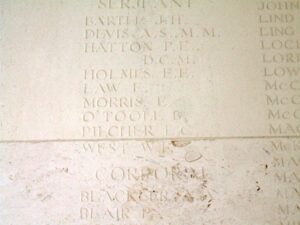
Augustus Charles Owen, MC, Second Lieutenant, Somerset Light Infantry. Augustus was the son of Sir Hugh Charles Owen and Lady Martha Owen, of Laurel Cottage, Goodwick. He was commissioned into the Somerset Light Infantry, and served with their 8th Battalion, attached to 63 Brigade, 21st Division. The battalion landed in France on 10 September 1915 and fought there for the remainder of the war. Augustus was awarded the Military Cross for his bravery during the desperate fighting suffered by the division early in 1918, his citation reading ‘For conspicuous gallantry and devotion to duty. At a critical moment he held his position with a small party of men against an enemy attack delivered after heavy bombardment. By his fine example of courage and determination he enabled the line in that part of the field to be restored’. Sadly Augustus was killed during the Battle of the Aisne, on 6 August 1918, aged 23. He is buried at St. Amand British Cemetery, France.
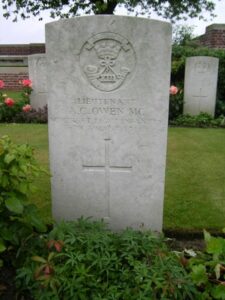
Harold Ewart Parcell, Private, 34091, Kings Shropshire Light Infantry. Harold was the son of Joseph and Lydia Parcell, of Tenby. Harold enlisted at Tenby into the South Wales Borderers, but later transferred into the 10th Battalion, King’s Shropshire Light Infantry, which was formed at Cairo on 2 March 1917 by the amalgamation of the Shropshire and Cheshire Yeomanry. The Battalion was attached to 231 Brigade, 74th (Yeomanry) Division, and fought in Palestine, during the three Battles of Gaza, and the capture of Jerusalem. After the German Offensive had severely weakened the British Armies in France, the Division were recalled to France, and landed at Marseilles during May 1918, and concentrated around Abbeville. The Division were brought into the line near Bapaume, and fought there for a short period before being moved to Flanders, where Harold was killed in action on 22 August 1918, aged 23. He is buried at Merville Communal Cemetery Extension, France.
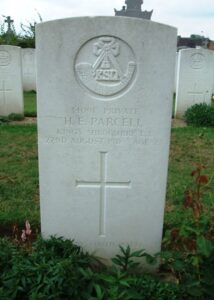
David Christopher Parry-Davies, Captain, South Wales Borderers. David was born in 1899, the son of David Rhys and Elizabeth Parry-Davies, of The Rectory, Puncheston, Pembrokeshire. He was commissioned into the South Wales Borderers on 31 October 1914, and promoted to Temporary Captain on 23 December 1915. He was posted to France on 24 September 1916, at first joining the 6th Battalion, South Wales Borderers. When the 2nd Battalion, South Wales Borderers moved to France from Egypt on 15 March 1916, David was transferred to them. They had been at Gallipoli in 1915 attached to 87 Brigade, 29th Division, and upon transferring to France took up positions at Beaumont Hamel. In April 1916, the 2nd SWB were the subjects of a raid by the Germans which caused heavy casualties, and resulted in a large number of men being taken prisoner. As a retaliatory gesture, on 29 April a Company of the battalion moved into No Man’s Land behind an artillery bombardment, to exact their revenge. Unfortunately the men were caught in their own bombardment, and suffered heavy casualties. David was badly wounded here, and died at No. 4 Casualty Clearing Station on 10 May 1916. He is buried at Beauval Communal Cemetery, France.
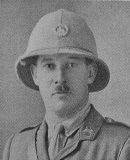
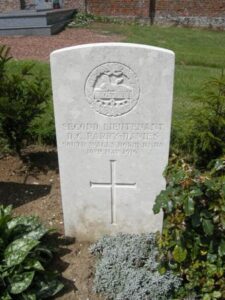
Edwin Steward Thomas Parsons, Petty Officer, 219856, Royal Navy. Edwin was born in Tenby on 14 October 1886, the son of Edwin and Annie E Parsons. The family later resided at 78 Lynton Grove, Copnor, Portsmouth, Hants. Edwin had married in 1909, and resided with his wife Ethel Rose Parsons (nee Mundell) at Portsmouth. Edwin was a pre-war regular in the Royal Navy, serving aboard HMS Good Hope, which was an antiquated Drake Class Armoured Cruiser, attached to the 6th Cruiser Squadron at Scapa Flow at the outbreak of war. The Good Hope was diverted to the Falkland Island, where she took part in the Battle of Coronel on 1 November 1914, and was sunk by the German Cruisers Scharnhorst and Gneisenau. Edwin was Killed in action during the loss of the ship aged 28, and is commemorated on the Portsmouth Naval Memorial. His brother Leonard Cecil Rhodes Parsons also fell. Edwin is not commemorated at Tenby.
Leonard Cecil Rhodes Parsons, Boy 1st Class, J/84403, Royal Navy. Leonard was born at Carnavon on 25 August 1902, the son of Edwin and Annie Parsons. The family later resided at 78, Lynton Grove, Copnor, Portsmouth. Leonard followed his brother Edwin, and served in the Royal Navy aboard HMS Carnarvon, which was a Devonshire Class Armoured Cruiser, which was the Flagship of the 5th Cruiser Squadron at the outbreak of war. She served in the Atlantic, and had fought at the Battle of the Falkland Islands in December 1914. then was stationed at Montevideo, and then at the West Indies, remaining between there and North America for the duration of the war. Leonard died of sickness on 26 October 1918, aged only 16, and is buried at Portsmouth (Milton) Cemetery. His brother Edwin Stewart Thomas Parsons also fell. Leonard is not commemorated at Tenby.
William Pearce, Private, 18175, Royal Defence Corps. William resided in Tenby, and enlisted at Mumbles into the 15th Battalion, Welsh Regiment. William was probably unfit for overseas service, and was transferred to the 331st Protection Company, Royal Defence Corps. William died on 20 April 1918 and is buried at Tenby (St. Mary) Church Cemetery.
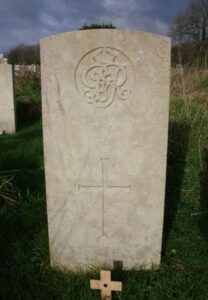
Francis John Pearson, Lance Corporal, 372499, London Regiment. Francis was born in Tenby, the son of John Henry Pearson and Jessie Mary Pearson. The family had moved prior to 1901, and resided at 91, Warham Street, Kennington Park, London. Francis enlisted at Lambeth into the 8th Battalion, London Regiment (Post Office Rifles), which was originally formed in August 1914 as part of the 2nd London Division. On 18 March 1915 they landed at Le Havre, and during May were attached to 140 Brigade, 47th Division. The Division fought at the Battles of Aubers and Festubert during May, 1915 and then fought at Loos from September 1915 onwards. During May 1916 they were at Vimy when the Germans attacked, and then moved to the Somme, where they fought at Flers-Courcelette and Le Transloy. During 1917 the Division took part in the Battle of Messines, and were still at Ypres when Francis was Killed in action on 20 September 1917, aged 21. He is commemorated on the Ypres (Menin Gate) Memorial, Belgium. Francis is not commemorated at Tenby.
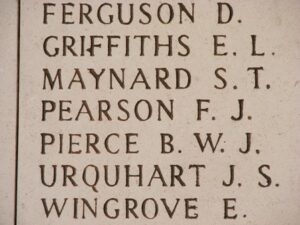
John Peate, Lieutenant, Gloucestershire Regiment. John was born at Llanbrynmair in 1889, the son of Margaret Peate of Ddolfach. He was educated at Machynlleth and Aberystwyth University, and was on the staff at Greenhill Grammar School, Tenby prior to the war. John married Ethel Gertrude Hicks at Tenby in 1915 and the couple lived at Marlborough House, South Cliff Street, Tenby. John was commissioned into the 3rd Battalion, Gloucestershire Regiment, and was posted into the 1st Battalion, Gloucestershire Regiment, which had been in France since the outbreak of war, attached to 3 Brigade, 1st Division. John joined the battalion in time to take part in the Somme Offensive on July 1916, probably arriving before the 1st Division moved to the Somme from Loos. By 5 July the 1st Gloucester’s had reached Bruay, and moved to billets in Albert by 11 July, prior to moving into the front line near Contalmaison. The 1st Division saw its first action on the Somme during the Battle of Bazentin soon afterwards, fighting to the right of the Australians as they assaulted Pozieres Ridge, and suffered terribly during the fighting around the OG lines. Heavy fighting, interspersed with rest periods, carried on over the coming weeks. By 7 September the 1st Gloucester’s moved into positions to carry on the offensive towards High Wood, and at dawn on the following morning launched their assault. Unfortunately the artillery support fell short, and many casualties were suffered from friendly fire. John was killed when the 1st Gloucester’s attacked High Wood on 8 September 1916. The 27-year-old has no known grave, and is commemorated on the Thiepval Memorial, France.
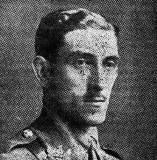
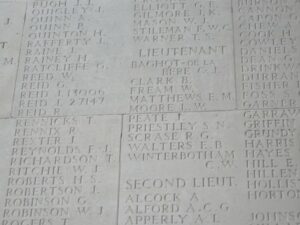
Ernest Powell, Private, 101168, Machine Gun Corps. Ernest was the son of George and Ann Powell, of 19, Culver Park, Tenby. He enlisted on 9 October 1914, and served throughout the war on home service with the Machine Gun Corps. Ernest married Lydia Leonora Maud Stevens at Brighton on 12 October 1917, before he posted to the Heavy Branch, Machine Gun Corps. He was taken ill before being sent to France, and hospitalised for a while with stomach problems. Ernest was discharged on 11 May 1918, and died on 2 May 1919, aged 39. He is buried in Tenby (St. Mary) Church Cemetery. Lydia died in 1934.
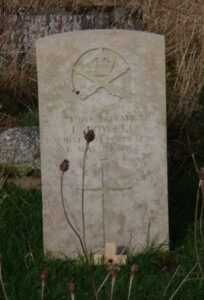
Evan Pritchard, Private, 54620, Welsh Regiment. Evan was the son of Hugh and Martha Pritchard, of Tyllosg, Maenclochog, Clynderwen. He resided at Tenby prior to the war, and enlisted at Cardiff into the 9th Battalion, Welsh regiment, attached to 58 Brigade, 19th (Western) Division. The Division assembled around Bulford during September 1914. Divisional training was completed near Tidworth, from March 1915, and the Division crossed to France during July 1915, moving to positions near Loos. The Division fought during the opening attack of the Battle of Loos, and then moved to the Somme, where they took part in the second wave of the attack on Ovillers-La Boiselle on 1 July 1916, capturing the village at heavy cost, and fought through the Somme Battles of Pozieres and the Ancre in 1916. They then moved North to Ypres, taking part in the Battle of Messines, and fought on the Menin Road and at Polygon Wood, before moving up to Broodseinde, Poelcappelle and Passchendaele Village itself. They then moved into positions on the Somme, which is where Evan was wounded. He died on 27 February 1918, aged 35, and is buried at Hermies Hill British Cemetery, France.
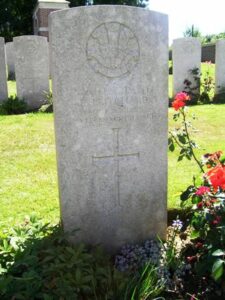
Charles Cecil Rand, Lance Corporal, 6380, Wiltshire Regiment. Charles was born at Brixton in 1881, the son of Charles Joshua and Sarah Rand. He was a pre war regular, serving with the 2nd Battalion, Wiltshire Regiment, and was based in Pembrokeshire when he married Elizabeth Jane Lewis in 1906. The couple resided at Tenby prior to the war, where Charles found work as a window cleaner. He was recalled to the colours at the outbreak of war, joining 1st Battalion, Wiltshire Regiment, which landed in France on 14 August 1914 attached to 7 Brigade, 3rd Division. The division fought during the opening Battle of Mons, and in the epic retreat, from the Rearguard Action of Solesmes, through the Battle of Le Cateau, and down to the Marne, where the German Offensive was stopped. They followed the German withdrawal to the Aisne, where they met them in battle, and stopped the advance on Paris. Charles was killed on the Marne on 23 September 1914, aged 33. He has no known grave, and is commemorated on the La Ferté-Sous-Jouarre Memorial, France.

Henry Arthur Rees, Gunner, 124170, Royal Garrison Artillery. Harry was the son of John Rees and Martha Rees, of 10, St. John’s Hill, Tenby. He enlisted at Llanelli into the Royal Garrison Artillery, serving in their 284th Siege Battery, and was Killed in action during the opening bombardments of Third Ypres, on 20 July 1917 aged 29. He is buried at Dickebusch New Military Cemetery Extension, Belgium.
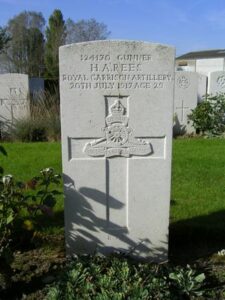
James Frederick Rees, Private, 320088, Welsh Regiment. James was the son of George and Mary Ann Rees, of 3, Frogmore Terrace, Tenby. He had enlisted at Tenby into the Glamorgan Yeomanry, which had arrived in Egypt in March 1916, and on 2 February 1917 were disbanded, joining with the Pembroke Yeomanry to form the 24th Battalion, Welsh Regiment, as part of 231 Brigade, 74th (Yeomanry) Division. The Division first saw action during the Second Battle of Gaza, and then defeated the Turks at the Third Battle of Gaza, where James was wounded. Sadly, he Died of Wounds on 6 November 1917, aged 23, and is buried at Beersheba War Cemetery, Israel. Many thanks to Avril Marks for the photograph.
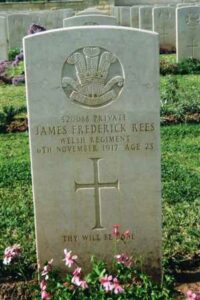
Joseph Rees, Driver, 8494, British Red Cross Society. Joseph was born at Tenby in 1891, the son of Joseph and Ellen Rees. He had originally enlisted into the South Wales Borderers in August 1914, but was discharged as medically unfit on 16 February 1915, suffering with tuberculosis. Joseph was undeterred, and volunteered to serve on the Western Front from 22 March 1916 as an ambulance driver with the British Red Cross Society. Joseph died at home on 6 August 1918, aged 27. He is buried in Tenby (St. Mary) Church Cemetery.
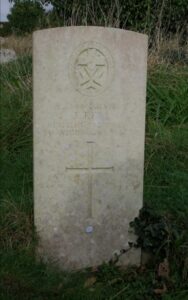
Charles Edward Richards, Private, 48990, Royal Army Medical Corps. Charles was born at Yockleton, Shropshire in 1894, the son of Evan and Mary Jemima Richards. By 1901 the family had moved to Cambrian Cottages, Tenby. Little is known of Charles’ wartime service, except that he served in the Royal Army Medical Corps, and died at Andover on 9 March 1916, aged just 21. He is buried at Tenby (St. Mary) Church Cemetery.
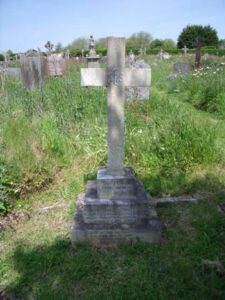
John Philpin Richards, Petty Officer, 1695C, Royal Naval Reserve. John was born at Tenby on 12 September 1877, the son of George and Mary Richards. He married Margaret Ann Jenkins in 1904, and the couple resided at 16, Trafalgar Road, Tenby, with their two sons. John served with the Royal Naval Reserve aboard H.M. Trawler Loch Naver. The Loch Naver was lost at sea on 13 May 1918 as a result of enemy action, and John was Killed in action aboard her. He was 40 years old, and is commemorated on the Plymouth Naval Memorial, Devon.
William John Richards, Petty Officer, 184496, Royal Navy. William was born at Neath on 18 February 1880, the son of William and Emily Richards. The family later moved to Tenby. William enlisted into the Royal Navy, and was based at Pembroke Dock. His wife, Elizabeth Gertrude Richards, resided at 18, North Street, Bufferland, Pembroke Dock. William served aboard the battleship HMS Goliath, which was part of the 3rd Fleet (Pembroke Reserve). At the outbreak of war, Goliath was re-commissioned, joining join the battle squadron operating from Devonport. Her complement was drawn up from the naval reserve on 2 August 1914. She was despatched in September 1914 to the East Indies for escort duties, operating against the German light cruiser Konigsberg in November (Rufigi River, East Africa). In April 1915 she was transferred to the Dardanelles, to support the ill-fated landings around Cape Helles. She was damaged on 25 April and again on 2 May 1915, and then finally sunk by 3 torpedoes fired by the Turkish torpedo boat Muavanet on 13 May 1915. 570 of her crew were lost, including William, who was 35 years old. He is commemorated on the Plymouth Naval Memorial, Devon.
Arthur Roberts, Private, 201032, Welsh Regiment. Arthur was born at Tenby in 1895, the son of Henry James Roberts and Agnes Roberts. The family had moved to 19, Upper Water Street, Llanelli prior to the war, and Arthur enlisted there into the 4th Battalion, Welsh Regiment. Arthur doesn’t look to have served overseas, and died at Llanelli on 13 July 1918, aged 22. Arthur is buried at Llanelli (Old Road) Church Cemetery. Arthur is not commemorated at Tenby.
Ralph Jennings Roberts, Lieutenant, Machine Gun Corps. Ralph was the son of George Rowland Roberts and Janet Roberts, of Newquay, Cornwall. He had been commissioned into the Army, and was posted to the 179th Company, Machine Gun Corps, attached to the 60th (2/2nd London) Division. The division had initially been on service in Ireland, but was posted to Salonika where it fought for ten months before being moved to Egypt, joining the forces in Palestine. Ralph was killed during his first action in Palestine, during the Third Battle of Gaza on 31 October 1917. He was 38 years old, and is buried at Beersheba War Cemetery, Israel.
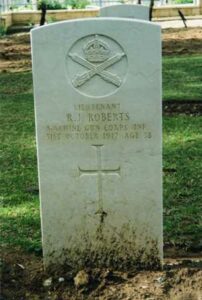
Evan Roblin, Private, 25846, Welsh Regiment. Evan was the son of James and Phoebe Roblin of Jeffreystone, and enlisted at Neath into the 18th Battalion, Welsh Regiment. The battalion was attached to 119 Brigade, 40th (Bantam) Division, and moved to France during June 1916. Late in 1916 they moved south to the Somme, and fought at the Battle of the Ancre, remaining in the area over the winter. In March 1917 the Germans withdrew to their shortened line, called the Hindenburg Line, and the 40th Division was one of the Divisions that followed the withdrawal. Later in the year they took part in the Battle of Cambrai, playing an important role in the attack on Bourlon Wood. They remained in the area over the coming months, but were caught here by the German Spring Offensive of 21 March 1918, and fought there at the Battle of St Quentin and retreating back westwards fought at the First Battle of Bapaume. Due to the terrible casualties suffered by the Division here they were sent north to Flanders to rest and rebuild, but in April the Germans launched an offensive in Flanders, and the 40th Division was caught up in the thick of it again, fighting at the Battle of Estaires, and then at the Battle of Hazebrouck. Following losses in the defence of Hazebrouck, the Division was reduced to a training cadre. A major reorganisation took place, with battalions that had been Garrison Guard units joining and being converted to fighting units. The Division was ready for front-line action again by 18 July 1918, when they took part in the Advance in Flanders, which is where Evan was killed on 29 July 1918. He was 43 years old, and is buried at Tournai Communal Cemetery, Allied Extension, Belgium.
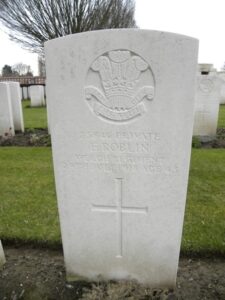
James Rossiter, Company Sergeant Major, 27475, Welsh Regiment. James was son of George and Mary Rossiter of Tenby, and the Husband of Mary Rossiter, of 2, Rocky Park, Tenby. He had served during the Boer War with the Imperial Yeomanry, and was discharged to the reserve in 1908. James rejoined the army at the outbreak of war, joining the 1st Battalion, Welsh Regiment. The battalion landed at Le Havre on 18 January 1915, attached to 84 Brigade, 28th Division. Upon arrival they moved to Ypres, and fought at the Battle of Second Ypres, where they suffered terrible casualties. In September 1915 they took part in the Battle of Loos, and on 24 November 1915 they embarked at Marseilles for Salonika, and arrived there on 25 November, remaining there for the duration of the war. James must have been wounded and returned home, as he died at home on 12 June 1918, aged 43, and is buried at Tenby (St. Mary) Church Cemetery.
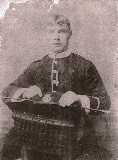
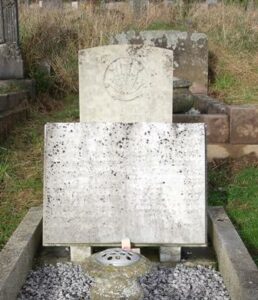
Angus Bowie Rutherford, Warrant Officer, Royal Navy. Angus was born on 23 December 1875, in Tarbert, Argyll, the son of Mary Rutherford. He probably resided at Tenby prior to the war, and fathered a daughter with Norma Elinor Nicholls in 1906. Angus served with the Royal Navy as a Gunner, aboard HMS Princess Irene. Princess Irene was built as a cruise ship, but was requisitioned by the Royal Navy and converted into a Minelayer. She was based at Sheerness in Kent. On 27 May 1915, she was in the River Medway, when a terrific explosion tore her apart, killing all her crew, except for one man. Angus was among the dead. He is commemorated on the Portsmouth Naval Memorial, Hampshire. Angus bequeathed his estate to Norma, to raise their daughter.
George Julian Ryan, DSO, Lieutenant Colonel, Royal Munster Fusiliers. George was born in Tenby on 18 September 1878, the son of Lt. Col. George Ryan (Army Medical Dept.) and Louisa Clotilda Ryan, later of Ashby Cottage, Ryde, Isle of Wight. George was educated at Elizabeth College, Guernsey and United Services College, Westward Ho!, Devon. On 8 September 1897 he was gazetted as Second Lieutenant into the Royal Munster Fusiliers, and was promoted to full Lieutenant on 11 March 1899. George fought during the Boer War with the Mounted Infantry, and fought at Kimberley, Belmont, Modder River, Transvaal, Cape Colony and the Orange River. He was Mentioned in Despatches on 10 November 1901, and also gained his Distinguished Service Order in South Africa. He then served in the Sudan, and was again Mentioned in Despatches whilst serving with the Egyptian Army from 6 February 1903 to 15 February 1910, and in that time was promoted Captain, on 6 June 1906. George returned to the Munster Fusiliers in 1910, and served with the 2nd Battalion as part of the BEF. They landed in France on 22 August 1914 as part of the 1st Division. The Battalion served at the Battle of Mons, and during the epic fighting retreat to the Marne, where the Germans were stopped. They suffered terrible casualties, and were removed from the line for several weeks to rebuild, but rejoined 3 Brigade, 1st Division on 9 November 1914 at Ypres. They fought at First Ypres, and were in Flanders throughout that first winter of 1914/15. In January, George was promoted to Lieutenant-Colonel and he was now in temporary command of the Battalion. On 23 January 1915 George was inspecting the front line trenches held by his Battalion at Givenchy, when he was Killed in action. He was 36 years old by now, and was buried in Guards Cemetery, Windy Corner, Cuinchy, France.
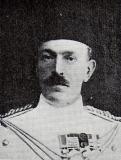

Walter Scott, Rifleman, G4249, Royal Fusiliers. Walter was born at Leeds, the son of Dr. Walter and Elizabeth Saies Scott, formerly of Tenby. He lived with his wife Eva Katherine Scott at 14, St. Lawrence Road, North Kensington, London prior to the war, and enlisted at London into the Royal Fusiliers. Walter was posted to their 24th Battalion, which was formed in November 1914. The battalion landed in Boulogne in November 1915 attached to 99 Brigade, 33rd Division, and the following month transferred to 5 Brigade, 2nd Division. The division was still at Loos, where it had played a leading role in the Battle of Loos. In the summer of 1916 the Division were on the Somme, and took part in the Battle of Delville Wood and the Battle of the Ancre, and the ensuing Operations on the Ancre. In March, 1917 the Division followed the German Retreat to the Hindenburg Line, and in April they fought at Arras, during the First Battle of the Scarpe, which is where Walter was killed on 13 April 1917, aged 30. He is buried at Bois-Carre British Cemetery, Thelus, France.
Ernest George Scurlock, Private, 11779, South Wales Borderers. Ernest was born at Tenby in 1886, the son of Edwin and Susanna Scurlock. The family later resided at 31, Oxford Square, Ogmore Vale, Bridgend. Ernest had enlisted at Cardiff into the 1st Battalion, South Wales Borderers. At the start of the war, the Battalion was at Bordon, attached to 3 Brigade, 1st Division, and moved immediately to France, landing at Havre on 13 August 1914. Here they moved to Belgium, and took part in the Battle of Mons, and then fought during the epic retreat southwards to the Marne, where the German Offensive was halted, and they followed the retreating Germans to the Aisne, where they again met them in battle. Ernest was Killed in action on the Aisne, on 26 September 1914, aged 29. He is commemorated on the La Ferte-Sous-Jouarre Memorial, France. Ernest is not commemorated at Tenby.
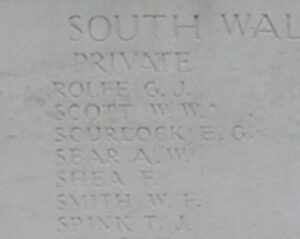
James Seaton, Able Seaman, 200194, Royal Navy. James was born on 2 July 1881, the son of Arthur and Mary Seaton, of Bristol. He was a long serving sailor, having been awarded the Long Service and Good Conduct Medal prior to the Great War, when he was posted to H.M.S. Defence. She was a Minotaur Class Armoured Cruiser, and was the Flagship of the First Cruiser Squadron during the Battle of Jutland, where she was struck by a German salvo which blew her up immediately. James was killed in that explosion, on 31 May 1916. He was 34 years old and is commemorated on the Plymouth Naval Memorial, Devon.
Arthur Smith, Private, 1155, Northamptonshire Yeomanry. Arthur was born at River View, Woodford, Northants on 24 September 1890, the only son of Charles Slater and Bertha Smith. The family later moved to Norton House Tenby. Arthur had been educated at Lewisham College, Weston-Super-Mare. He volunteered into the Northamptonshire Yeomanry on 8 September 1914, and as a successful National Hunt Jockey was accepted with open arms. In October 1914 the Northants Yeomanry joined the 8th Division, and proceeded to France in November, and saw their first major action at Neuve-Chappelle, where Arthur was killed in action on 9 March 1915, aged 24. He is buried at Vieille-Chappelle New Military Cemetery, France.
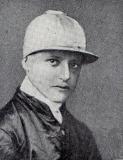
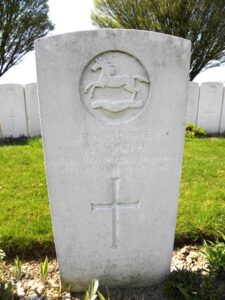
Arthur Smith, Private, 25271, Welsh Regiment. Arthur was born in Tenby in 1889, and was the Grandson of James and Elizabeth Smith, of St. Mary’s Street, Tenby. He was a coal miner for several years prior to the war, and enlisted at Mountain Ash into the 18th Battalion, Welsh Regiment, which was raised in January 1915 as a Bantam Battalion. They moved to Porthcawl attached to the 43rd Division, and then in July 1915 moved to Prees Heath in 119 Brigade, 40th Division. September 1915 saw them at Aldershot, and then during June 1916 the Division landed in France. The Division moved first to Loos, and remained there until October, 1916 when they moved to join the Somme Offensive, fighting at the Ancre. After a hard winter on the Somme, the Division followed the German withdrawal to the Hindenburg Line, and took part in the 1917 Battle of Cambrai, where they attacked Bourlon Wood. They were in the area during the German Spring Offensive of March 1918, and they fought during the First Battle of Bapaume where Arthur was killed in action on 24 March 1918, aged 22. He is commemorated on the Arras Memorial, France. Arthur is not commemorated at Tenby.
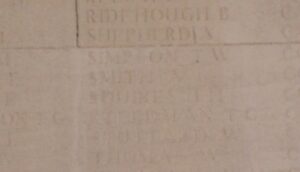
Gilbert James Smith, Private, 320258, Welsh Regiment. Gilbert was born at Manorbier in 1883, the son of William and Jane Smith. The family moved to 6, Queen’s Parade, Tenby prior to 1891. Gilbert enlisted at Carmarthen into the Pembroke Yeomanry, which had formed in Tenby for Home Defence, as part of the South Wales Mounted Brigade. They arrived in Egypt in March 1916, and on 2 February 1917 were disbanded, joining with the Glamorgan Yeomanry to form the 24th Battalion, Welsh Regiment, as part of 231 Brigade, 74th (Yeomanry) Division. The Division first saw action during the Second Battle of Gaza, and then gained a victory over the Turks at the Third Battle of Gaza before capturing Jerusalem during December 1917. Gilbert was wounded during the Battle of Jerusalem and Died of Wounds on 6 December 1917, aged 34. He is buried at Jerusalem War Cemetery, Israel.
Hubert George Smith, Private, 320057, Welsh Regiment. Hubert was the son of William Henry Smith and Sarah Ann Smith (nee Richards), of Cresswell Street, Tenby. He married Winifred L Jones in 1911, and the couple resided at Alpha Cottage, Lower Frog Street, Tenby. Hubert had enlisted at Tenby into the Pembroke Yeomanry, which had formed in Tenby for Home Defence, as part of the South Wales Mounted Brigade. They arrived in Egypt in March 1916, and on 2 February 1917 were disbanded, joining with the Glamorgan Yeomanry to form the 24th Battalion, Welsh Regiment, as part of 231 Brigade, 74th (Yeomanry) Division. The Division first saw action during the Second Battle of Gaza, and then gained a victory over the Turks at the Third Battle of Gaza before capturing Jerusalem during December 1917. After further service in Palestine, the Division was ordered to France, and arrived at Marseilles in May 1918 before being rushed to the Somme area to take part in the Battle of Bapaume, where the Germans were pushing the British back over the hard won battlefields of 1917. After a spell in Flanders, the Division were brought back to the Somme, where they fought in the Battle of Épehy, which paved the way for the attacks on the Hindenburg Line. They then pushed on into the Artois area, where Hubert sadly Died on 6 November 1918, aged 27. He is buried at Don Communal Cemetery, Annoeullin, France.

John Henry Smith, Sergeant, 13285, Welsh Regiment. John was born in Tenby in 1892, the son of Samuel and Mary A. Smith. The family later resided at 35 St. David Street, Blaengarw. John had married prior to the war, and resided with his wife Gladys Smith, at 40, Nanthir Road, Blaengarw. He enlisted at Bridgend prior to 1911 into the Welsh Regiment, and at the outbreak of war joined the 9th Battalion, Welsh Regiment, which had been formed at Cardiff in September 1914. The battalion moved to Salisbury Plain in 58 Brigade, 19th (Western) Division, and in July 1915 landed at Havre. The Division moved to positions near Givenchy, taking up positions near Neuve-Chapelle. It saw its first major action during the Battle of Loos. John was Killed in action during the initial offensive on 25 September 1915, aged 23. He is commemorated on the Loos Memorial, France. John is not commemorated at Tenby.
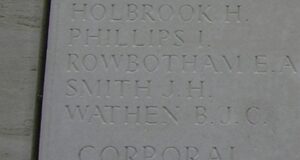
William Arthur Smith, Private, 320499, Welsh Regiment. William was born on 16 January 1889, the son of William and Sarah Ann Smith, of Green Grove Cottage, Park Terrace, Tenby. He married Alice Beatrice Davies in 1910, and the couple resided at 3, Upper Frog Street, Tenby. William enlisted at Carmarthen into the Welsh Regiment, and was posted to the 24th Battalion, which was attached to 231 Brigade, 74th (Yeomanry) Division in Palestine. William Died at Sea on the voyage out on 1 January 1917, aged 28, and was buried at sea. William is commemorated on the Mikra Memorial, Salonika.
Ernest George Charles Stratford, Rifleman, 323378, London Regiment (City of London Rifles). Ernest was born at Moville, Donegal on 7 August 1892, the son of George and Alice Stratford. George had been the Station Master at Tenby Lifeboat Station prior to the war, before retiring to 88, Folkestone Road, Copnor, Portsmouth. Ernest worked as a Draper in London, and enlisted at Croydon into the 2/4th Battalion, East Surreys. He landed in France on 1 September 1916, and was transferred to the 1/6th Battalion, City of London Rifles, attached to 140 Brigade, 47th (London) Division. Ernest saw his first major action on the Somme, where the Division fought at the Battle of Flers-Courcelette, and then at the Battle of Le Transloy, where the Division captured Eaucourt l’Abbe, and took part in Attacks on the Butte de Warlencourt. Early in 1917 the Division moved north to Belgium, and took part in the Battle of Messines, and then in November, 1917 fought at the Battle of Cambrai. Ernest was killed here on 6 December 1917, aged 25. He was originally buried on the battlefield near Flesquireres, but his grave was lost during further fighting, and Ernest is commemorated on the Cambrai Memorial, Louverval, France.
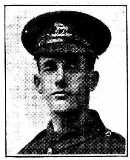
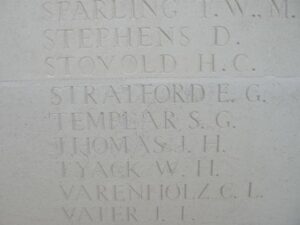
William Childs Sudds, Sergeant, 5468, Welsh Regiment. William was the son of George and Elizabeth Ann Sudds, of 22, Blackheath Vale, Blackheath, London. He had been based at Pembroke Dock with the Welsh Regiment prior to the war, and married Lucy Ann Rees, of 3, Frogmore Terrace, Tenby, in 1912. William served in the 2nd Battalion, Welsh Regiment, which moved to France in August 1914 as part of 3 Brigade, 1st Division. The Division was quickly moved to Belgium, and fought in the Battle of Mons, and in the epic retreat south to the Marne, where the German Offensive was halted. They then fought at the Battle of the Aisne before moving to Ypres, and they halted the German sweep through Flanders during the Battles of First Ypres. William was Killed in action here on 31 October 1914, aged 34, and is commemorated on the Ypres (Menin Gate) Memorial, Belgium. Lucy died in 1944.
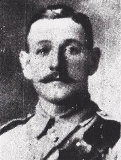
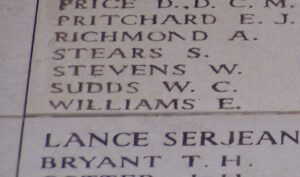
Daniel James Taylor, Private, 7012, Duke of Edinburgh’s (Wiltshire) Regiment. Daniel was born at Stratton, Wiltshire. He was a regular soldier, and had married Alice Maud Jermyn, the daughter of Ann Jermyn, of St. Domingo Place, Tenby in 1906. Margaret later moved to 9, Laburnum Terrace, Dunvant, Swansea. Daniel served with the 1st Battalion, Wiltshire Regiment, which was part of 7 Brigade, 3rd Division. The Division moved to France, landing at Rouen on 14 August 1914 and fought in the Battle of Mons, and in the action at Solesmes and the Battle of Le Cateau. From here on they fought in the epic retreat to the Marne, where the German attack was stopped, and fought on the Aisne before moving to Flanders, fighting at the Battles of La Bassée, Messines, and First Ypres. They remained in the area during the winter, and it was here that Daniel was Killed in action on 12 March 1915. He is buried in La Laiterie Military Cemetery, Belgium. Alice died in 1938.
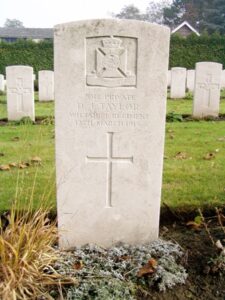
Frederick Charles Thomas, Private, 12588, South Wales Borderers. Frederick was born at Tenby, the son of John and Harriet Thomas. The family had moved to 21, New Castle Square, Bridgend prior to the war, and Frederick enlisted at Bridgend into the 4th Battalion, South Wales Borderers. The battalion formed at Brecon in August 1914, then moved to Park House Camp, near Tidworth in 40 Brigade, 13th Division. On 29 June 1915 the Division sailed from Avonmouth for Mudros, and landed on Gallipoli on 15 July 1915. They fought throughout the remainder of the campaign here, during the Battles of Sari Bair and Russell’s Top, where Frederick was wounded. He died of wounds aboard a hospital ship on 13 August 1915, aged 21. Frederick was buried at sea, so is commemorated on the Helles Memorial, Gallipoli.
Henry Percival Thomas, Sapper, 200442, Royal Engineers. Henry was born in 1891, the son of Herman and Eleanor Thomas, of 1, St. Julian Street, Tenby. He enlisted at Ashby-De-La-Zouch in September 1914 into the 1/5th Battalion, Leicester Regiment. He served with the battalion in France until 24 August 1916, when he was transferred into the Royal Engineers, and served in their I.W. & D. Section in Mesopotamia. Henry contracted sandfly fever in Mesopotamia, and died of septicaemia on 27 September 1917, aged 26. He is buried at Basra War Cemetery, Iraq.
Howell Tudor Thomas, Corporal, 108725, Royal Engineers. Howell was the son of William and Annie Thomas, of Tenby. He married Eva Mary Williams on 2 April 1907, and the couple resided at Ford Cottage, Edward Street, Tenby. Howell enlisted on 6 December 1915 into the Army Service Corps, but was immediately transferred to the Royal Engineers. Howell served for the remainder of the war with the 222nd Field Company, Royal Engineers. He remained in France after the armistice, and died of pneumonia on 31 January 1919 aged 37. Howell is buried at Janval Cemetery, Dieppe, France.
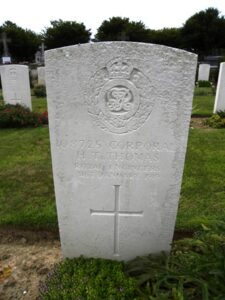
Sydney Thomas, Private, 34089, Welsh Regiment. Sydney was born in Tenby in 1880. His parents later moved the family to Ferndale (Rhondda), and Sydney married in 1900, living with his wife Hannah Thomas, at 12, Penybryn, Penallu Road, Ystrad Mynach, Glam. He enlisted at Caerphilly into the 9th Battalion, Welsh Regiment, which had been formed at Cardiff in September 1914, and moved to Salisbury Plain in 58 Brigade, 19th (Western) Division. In November 1914 they moved to Basingstoke in billets, then in January 1915 to Weston-super-Mare. In May 1915 they moved to Perham Down, and in July 1915 landed at Havre. The Division moved to French Flanders, and fought in the Battle of Loos, and in 1916 moved to the Somme, where they fought throughout the 1916 offensive, which is where Sydney was Killed in action on the Ancre on 27 October 1916, aged 36. He is commemorated on the Thiepval Memorial, France. Sydney is not commemorated at Tenby.
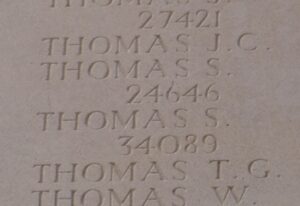
Wilfred George Thomas, Private, 53649, Cheshire Regiment. Wilfred was the son of Frederick and Laura Helen Thomas, of Farnham House, South Cliff Street, Tenby. He enlisted at Tenby on 9 February 1917 into the Training Reserve, and was posted to France on 8 April 1918, joining the 1st Battalion, Cheshire Regiment, which was attached to 15 Brigade, 5th Division. The division had just returned to France from Italy, and in April 1918 were hurriedly returned to France, where they moved to Flanders to help in the desperate defence there. Wilfred was killed in action on 3 July 1918, aged just 18. He is buried in Tannay British Cemetery, Thiennes, France.
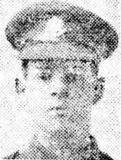
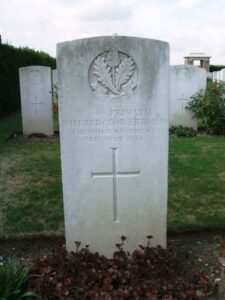
Alfred James Veale, Private, 4818, Hampshire Regiment. Alfred was born in Paddington on 22 December 1875, the son of Alfred and Sophia Veale. He married Mary Annie Ryal, of Tenby, on 10 February 1901. Alfred enlisted at Winchester into the 11th Battalion, Hampshire Regiment, which had been formed at Winchester in September 1914, and moved to Dublin, as Army Troops attached to the 16th Division. In September 1914 they moved to Mullingar, and in December, 1914 became the Pioneer Battalion to the 16th Division. On 18 December 1915 the Division landed at Havre, and concentrated in the Bethune area. Alfred was wounded near Bethune and Died of Wounds there on 9 June 1916, aged 40. He is buried in Bethune Town Cemetery, France.
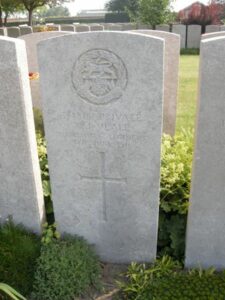
John Henry Lyons Walcott, Lieutenant, Indian Army. John was born at Tenby on 2 May 1894, the son of Robert Courtland Shaw Walcott and Eva Walcott. The family later resided at 13, Cavendish Road, Southsea. John had been commissioned into the 2nd Gurkha Rifles, but at the outbreak of war was attached to the 34th Sikh Pioneers, which were rushed to the Western Front in time to fight at the First Battle of Ypres. They were in positions around the Neuve-Chapelle, sector when John was killed in action on 2 November 1914. He was just 20 years old, and is commemorated on the Neuve-Chapelle Memorial, France.

Frederick Warner, Private, 9321, Welsh Regiment. Frederick was born at Southwark, London in 1889. He was a boy soldier at Pembroke Dock prior to the war, and married Esther Martha Brooking, of Crackwell Street, Tenby in 1912. Frederick served with the 2nd Battalion, Welsh Regiment, which was part of 3 Brigade, 1st Division, and landed in France on 13 August 1914. The division moved to the Belgian border, where they saw action at the Battle of Mons, and in the subsequent retreat south through Le Cateau to the Marne where they helped stem the German offensive. After playing a vital part in the Battle of the Aisne, the division moved to positions at Ypres, where they took part in the First Battle of Ypres, which stopped the German drive to the coast. Frederick was wounded at Ypres, and died on 3 November 1914, aged 24. He is buried at Ypres Reservoir Cemetery, Belgium.
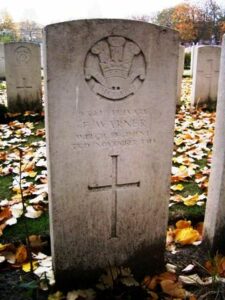
John Patrick Waters, Second Lieutenant, Royal Flying Corps. John was the only son of General Hely-Hutchinson Waters, CMG, CVO, of Glendower, Tenby, and of and Mrs. E. M. Waters, of Barton Stacey, Sutton Scotney, Hants., He was commissioned in July 1917 into the Royal Flying Corps, and was posted to France with 56 Squadron, which was one of the most famous fighter squadrons of the Great War, equipped with the SE5a. On 18 November 1917, John took off in the aeroplane of the famous Fighter Ace, Gerald Maxwell, which was SE5a, Serial B502. The aircraft broke apart on landing, killing John. He was just 18 years old, and is buried at Dernancourt Communal Cemetery Extension, France. John is not commemorated at Tenby.
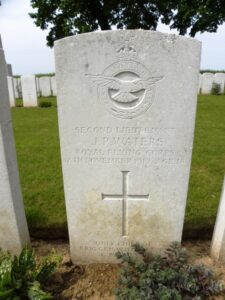
William Way, Sergeant, 19717, York and Lancaster Regiment. William was born at Tenby in 1892, and worked as a collier at Pontypridd prior to the war. He enlisted at Porth into the Yorkshire Light Infantry, but later transferred into the 2nd Battalion, York and Lancaster Regiment, which had landed at St. Nazaire on 9 September 1914, attached to 16 Brigade, 6th Division. The Division reinforced the BEF on the Aisne, before moving to Ypres, where they fought at Hooge. They fought through much of the 1916 Somme Offensive, and at Hill 70 and the Battle of Cambrai in 1917. They were heavily involved in the desperate defensive period of 1918 after the German Spring Offensive had wreaked havoc on the British Lines, and were in Flanders when William was killed in action on 22 July 1918, aged 26. He is buried in Abeele Aeroplane Cemetery, Belgium.
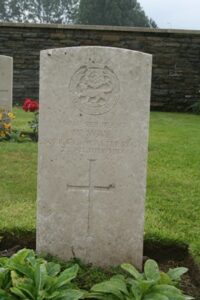
Edmund Henry Herbert Westby, Captain, Welsh Regiment. Edmund was born at Tenby in 1881, the son of Captain John Wright Westby, and Charlotte Sarah Constance Westby, of Tenby. He was the husband of Jessie Primrose Josephine Vera Westby (nee David), of Dorling House, Fleet, Hants. Edmund was a long serving officer, having served in the South African Campaign, and at the outbreak of the Great War was Captain in the 1st Battalion, Welsh Regiment, which was in Chakrata, India, as part of the Dehra Dun Brigade in Meerut Division. The battalion was recalled back to Britain, and returned to England, landing at Plymouth on 22 December 1914, joining 84 Brigade, 28th Division. The Division formed in England between December 1914 and January 1915 from regular units returning from India, Singapore and Egypt. During January 1915 it moved to France, landing at Le Havre and moved to the Western Front, where it saw its first major action during the Second Battle of Ypres. Edmund was killed here during an attack on Railway Wood on 25 May 1915, aged 33. Edmund is commemorated on the Ypres (Menin Gate) Memorial, Belgium.
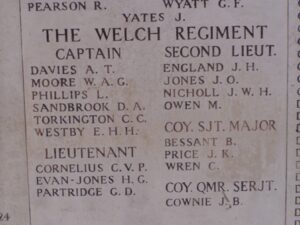
George Thomas Wickland, Lance Sergeant, 15511, Royal Welsh Fusiliers. George was the son of Benjamin and Dorothy Wickland, of Burnham Cottage, Crackwell Street, Tenby. He enlisted at Swansea into the 10th Battalion, Royal Welsh Fusiliers which had been formed at Formed at Wrexham on 16 September 1914, as part of 76 Brigade, 25th Division. On 27 September 1915 they landed at Boulogne, and on 15 October transferred with the Brigade to the 3rd Division. The Division were in Ypres at the time, and in July 1916 moved to the Somme, where they fought throughout much of the Offensive there. George was killed in action on the Somme on 16 August 1918, aged 25, and is commemorated on the Thiepval Memorial, France.
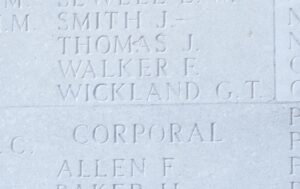
William Wickland, Able Seaman, Wales/Z/544, Royal Navy. William was born in 1895, the son of James Palmer Wickland and Sarah Wickland, of 1, St. Davids Cottage, Lower Frog Street, Tenby. He served in the Royal Navy aboard the Battle Cruiser HMS Indefatigable. She was commissioned in February 1911 and joined the 1st Cruiser squadron. She joined the 2nd battle Cruisers squadron in the Mediterranean at the outbreak of world war one in August took part in the pursuit of Goeben and Breslau and also bombarded Cape Helles. She became the Flagship of Admiral Carden in November 1914 until January 1915. After a refit at Malta she joined the Grand Fleet as part of the 2nd battle Cruiser Squadron and was sunk at Jutland by 11 inch shell fire from Van Der Tann. Official reports state she was hit by two shells in the X magazine causing her stagger out of formation sinking by the stern this was followed by another hit on the foredeck causing a much larger explosion which destroyed her. John was killed when Indefatigable blew apart on 31 May 1916. He was 20 years old, and is commemorated on the Plymouth Naval Memorial, Devon.
George Henry Williams, Private, 42171, Manchester Regiment. George was born in 1880, the son of Richard James Davies Williams and Elizabeth Williams. The family moved to Tenby when he was young. George married Mary Priscilla Truman at Tenby in 1902 and the couple had five children over the coming years. George had worked as a Groom for Lord St. David’s and Lord Hillingdon, prior to gaining work at Mr Harrison’s racing stables. George enlisted at Carmarthen into the Army Service Corps. George was sent to France to join the 17th Battalion, Manchester Regiment, attached to 90 Brigade, 30th Division. The Division moved to France in November 1915, and took part in its first major action during the Somme Offensive, at the Battle of Albert, where they captured Montauban. They then fought during the latter stages of the offensive, during the Battle of Le Transloy, before wintering on the Somme. In March 1917 the Division followed the German Retreat to the Hindenburg Line, and in April took part in the First Battle of the Scarpe, and then at the later Second Battle of the Scarpe. Later that year they were moved north to Ypres, and fought at the Battle of Pilckem. They then moved to positions near St. Quentin, which is where George was wounded. He died of wounds on 6 February 1918, aged 37, and is buried in Ham British Cemetery, Muille-Villette, France.
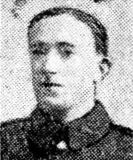
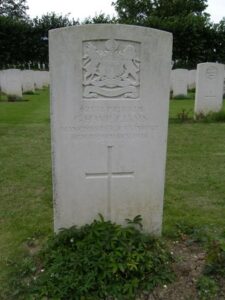
Gilbert Henry Williams, Private, 53364, Cheshire Regiment. Gilbert was the son of Hugh Lewis Williams and Ann Williams, of Church Farm, East Williamston, Tenby. He resided at 118, Victoria Street, Pontycwmmer prior to the war. Gilbert enlisted at Bridgend in February 1916 into the Welsh Regiment, and served in France with the 9th Welsh until 24 December 1916, when he was evacuated home with pleurisy. Gilbert was posted back to France with a draft for the 2nd Welsh in March 1918, but was transferred to the 11th Battalion, Cheshire Regiment, which was attached to 75 Brigade, 25th Division. The Division had been in France since 26 September 1915, and Gilbert joined his new battalion after it had been decimated during the German spring offensive of 21 March 1918. On 30 March the Division moved to Flanders, and were at Ploegsteert when the German Offensive hit. Gilbert was Killed in action here on 10 April 1918, aged 30, and is commemorated on the Ploegsteert Memorial, Belgium. Gilbert is not commemorated at Tenby.
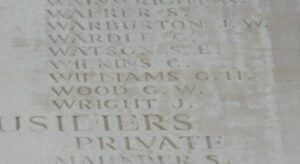
Arthur Wesley Wilson, Second Lieutenant, Scots Guards. Arthur was the son of Dr. Samuel Wesley Wilson and Annie Elizabeth Wilson, of 10 Stowe House, Broadstairs, Kent and the Grandson of Mr. and Mrs. Jones-Lloyd of 19, Victoria Street, Tenby. He was a Graduate of Sidney Sussex College, Cambridge, where he had studied Medicine, and he received his Commission into the Scots Guards in June, 1916. The Scots Guards were by now in France with the 3rd Guards Brigade, Guards Division, and Arthur joined them on the Western Front. He was posted to the 3rd Brigade M.G. Company, Guards Division, and joined them at Ypres. The Division took part in the Battle of Pilckem, during Third Ypres. Arthur was killed in action on 30 July 1917, aged 20, the night prior to the opening offensive. He is buried at Duhallow A.D.S. Cemetery, Belgium. Arthur is not commemorated at Tenby.
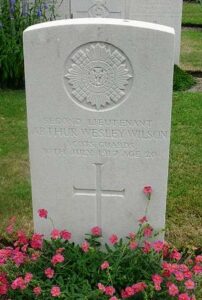
Albert Christopher Wrenn, Private, 7832, Kings Own Yorkshire Light Infantry. Albert was born at Newtown, Montgomeryshire in 1885, the son of William and Mary Wrenn. He married Ethel Hilda Lloyd in 1908, and the couple set up home at Tenby, where they raised two children. Albert enlisted at Pontypridd into the Army, joining the 10th Battalion, Kings Own Yorkshire Light Infantry, attached to 64 Brigade, 21st Division. The Division crossed to France during September 1915, and its first experience of battle was truly appalling. Having been in France for only a few days, it was sent into action at Loos on 26 September, where it suffered over 3,800. The Division moved to the Somme in 1916, and fought at the Battle of Albert, then at the Battle of Bazentin, the Battle of Flers-Courcelette and the Battle of Morval, capturing Gueudecourt before taking part in the Battle of Le Transloy. In March, 1917 they followed the German Retreat to the Hindenburg Line, and in April fought at Arras, during the First Battle of the Scarpe, the Third Battle of the Scarpe, and the Flanking Operations Round Bullecourt. Albert was killed here on 5 June 1917, aged 32. He is buried at Henin Communal Cemetery Extension, France.
